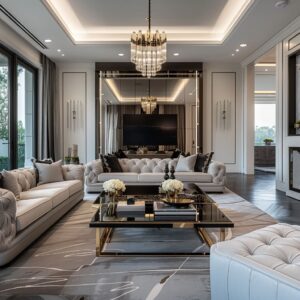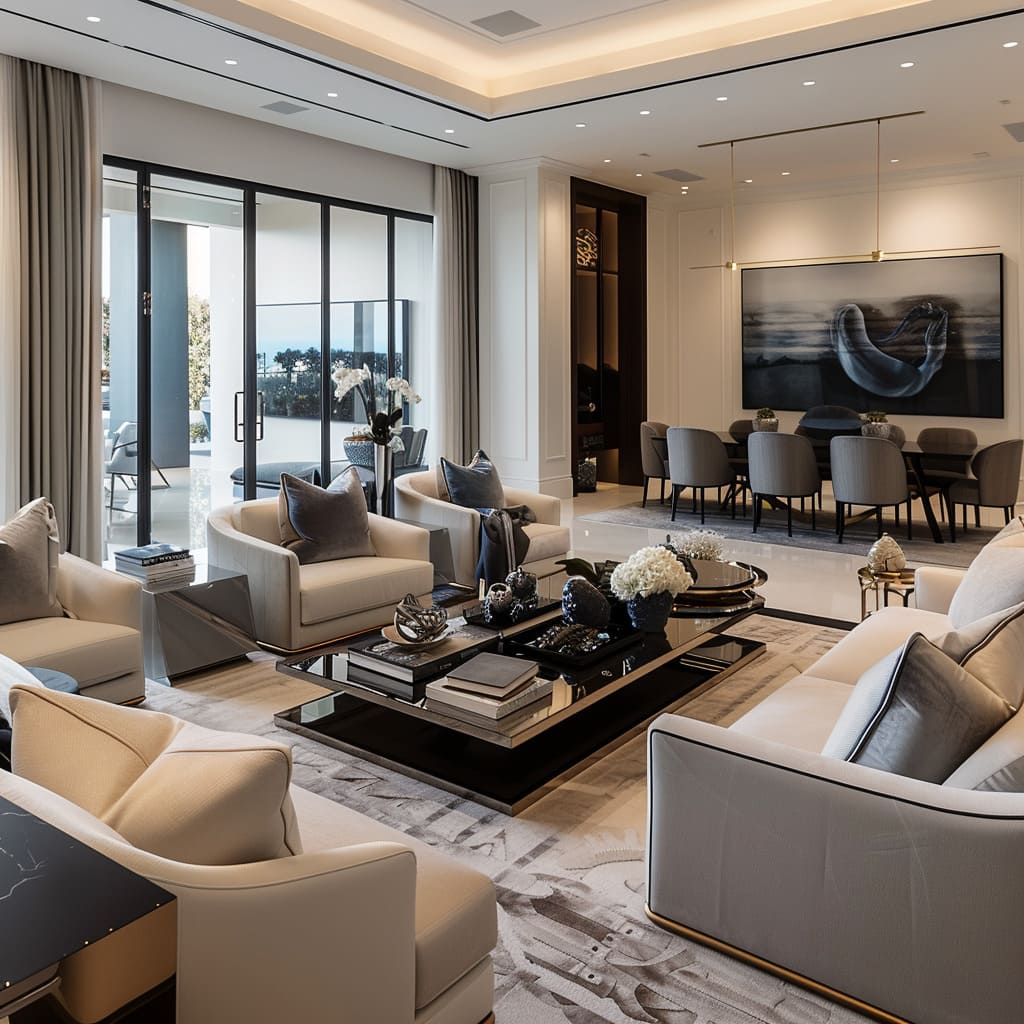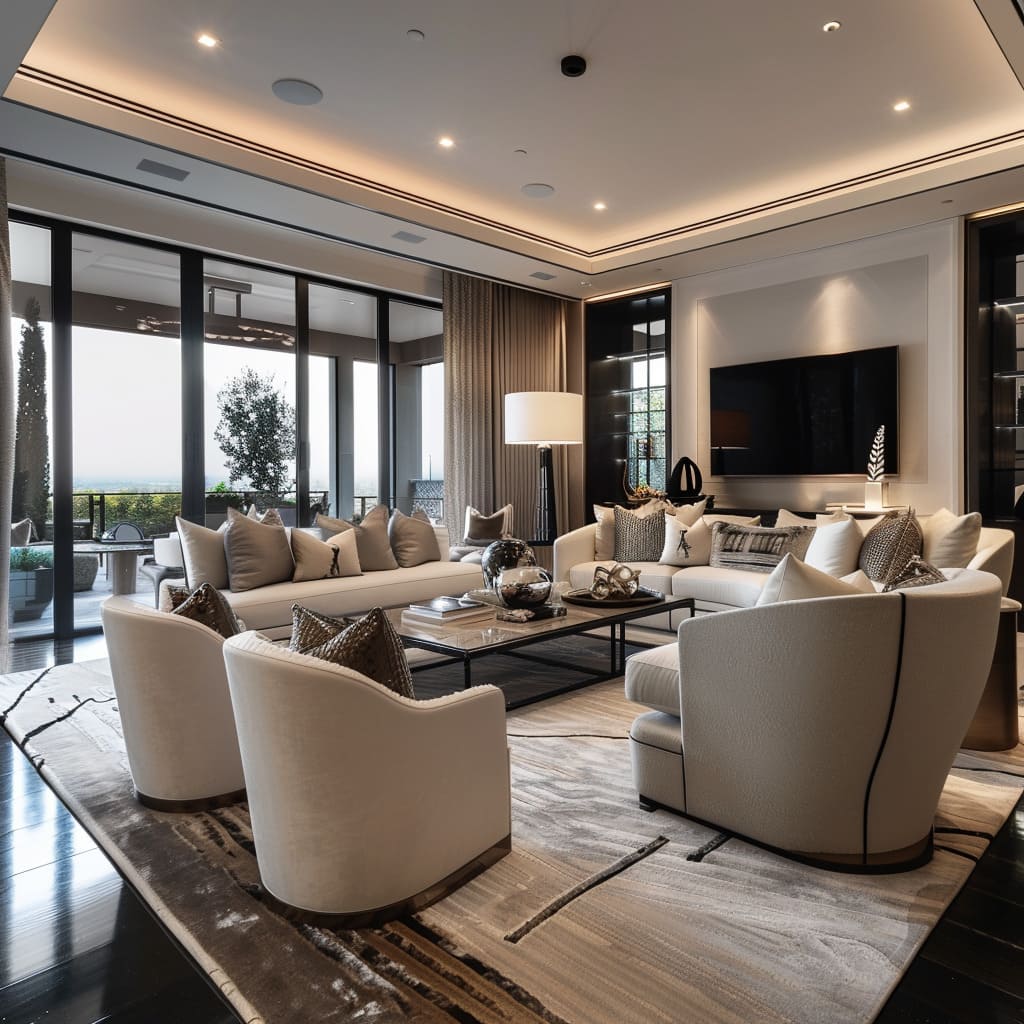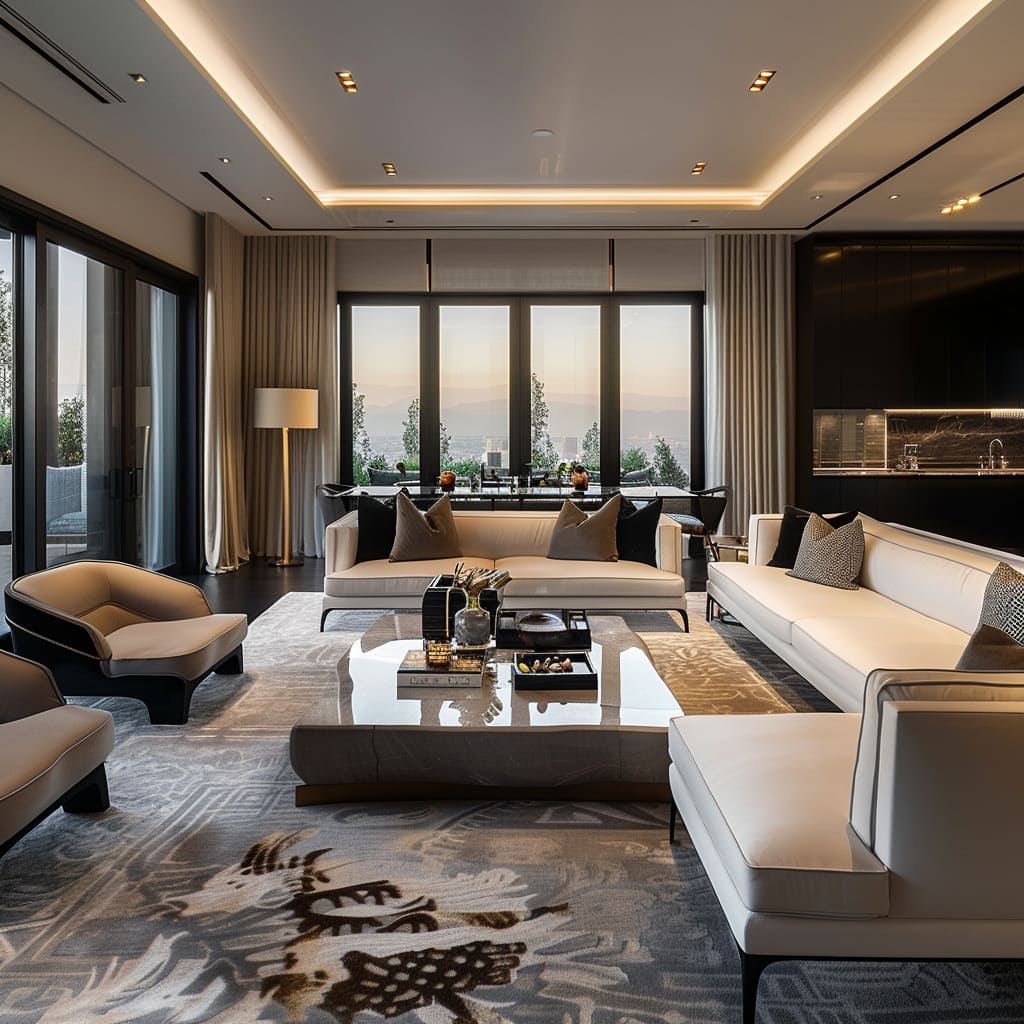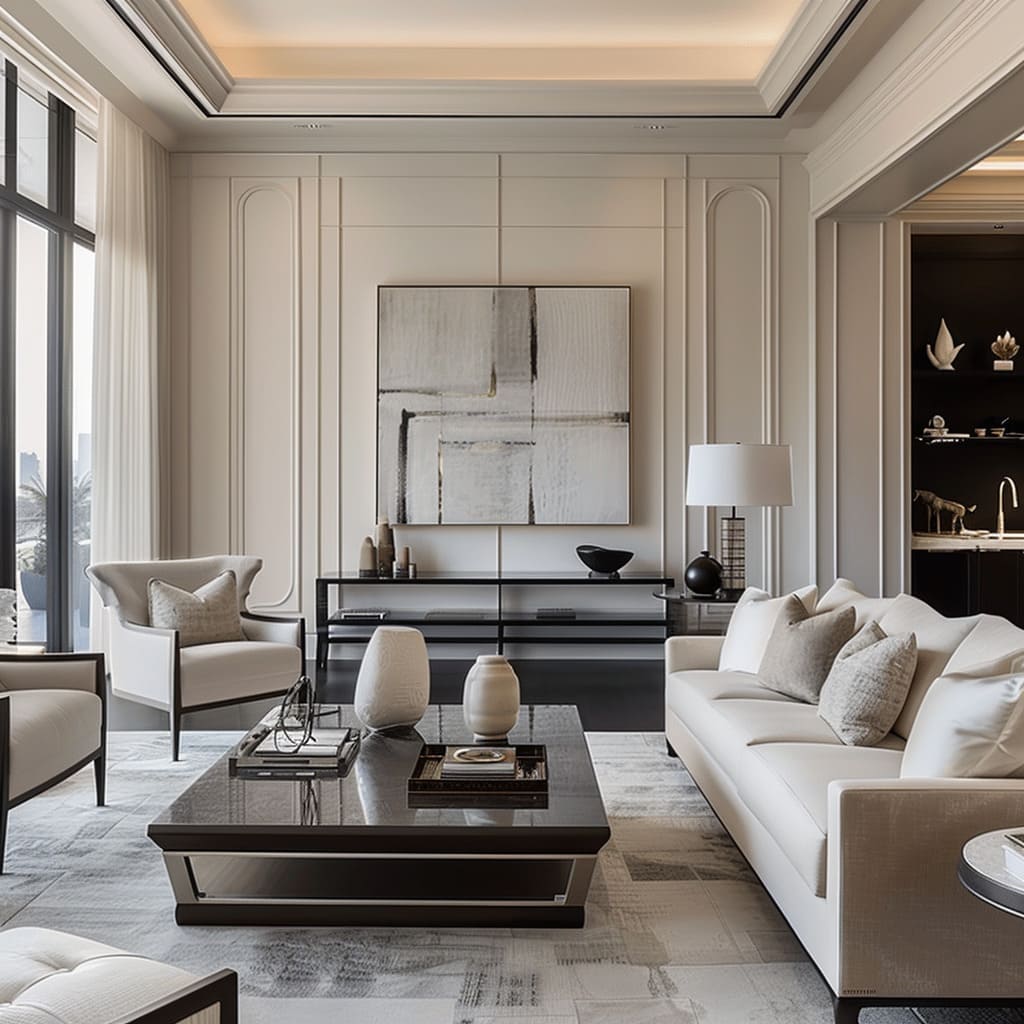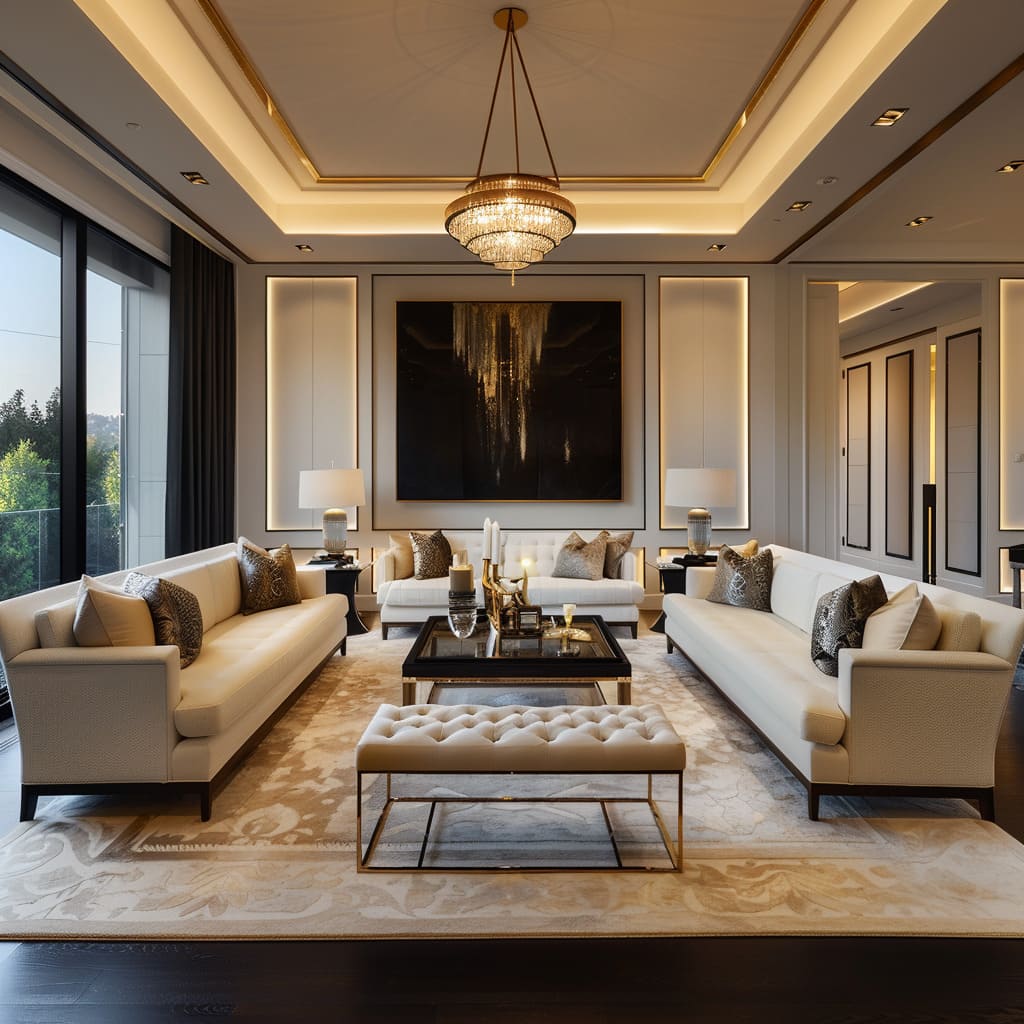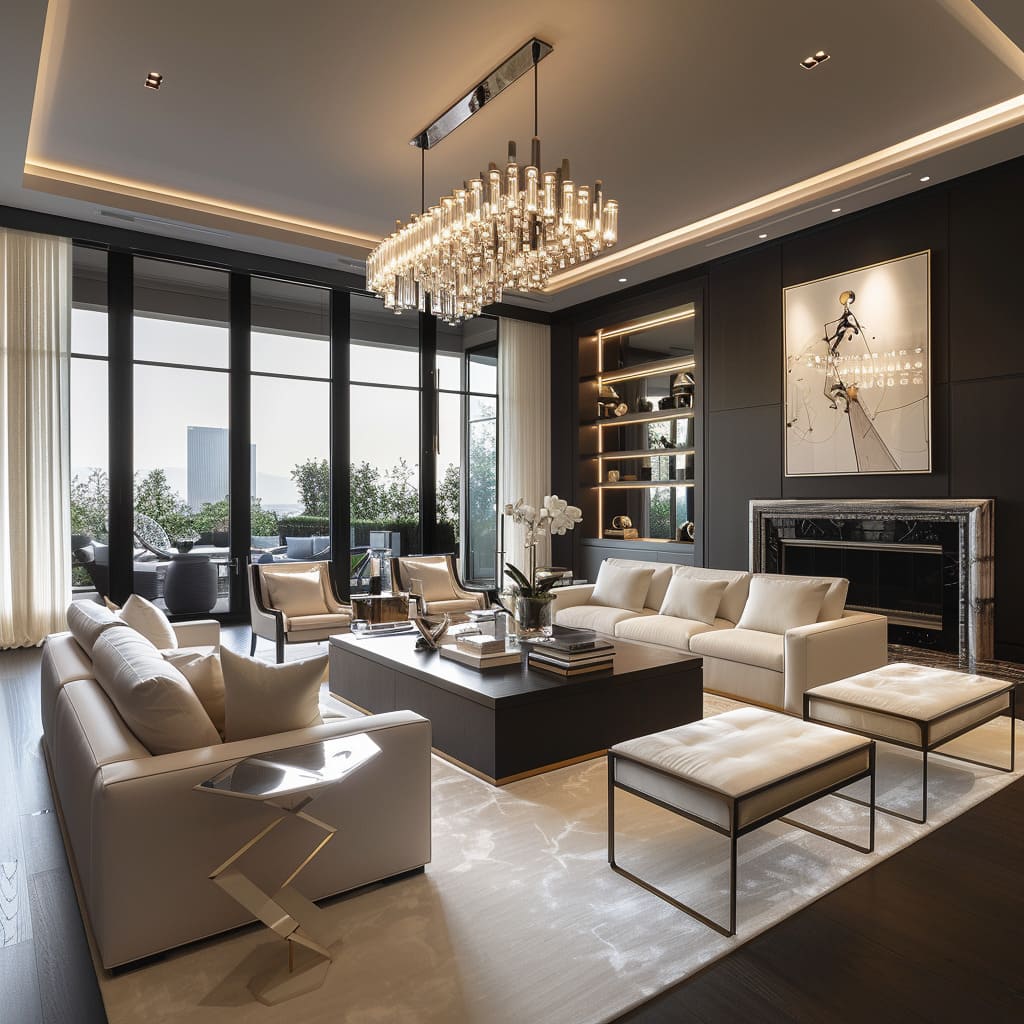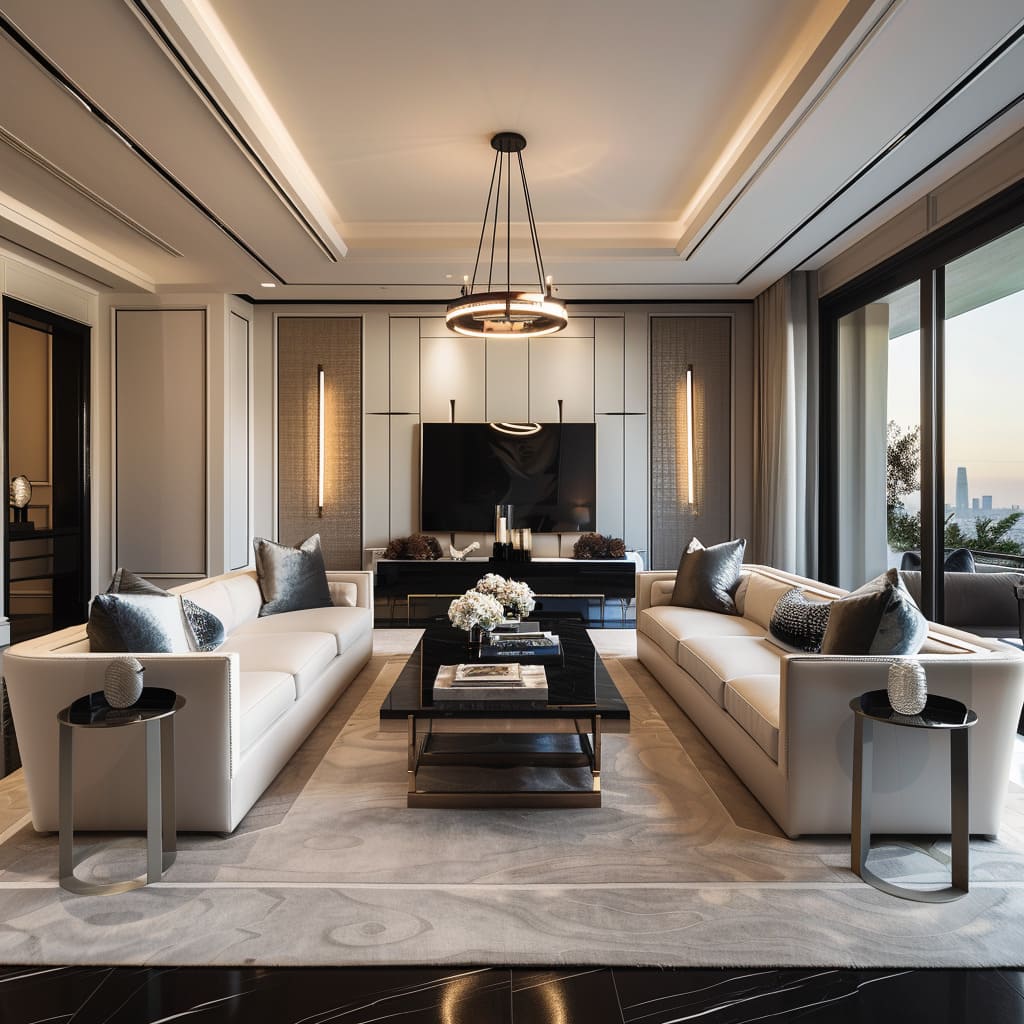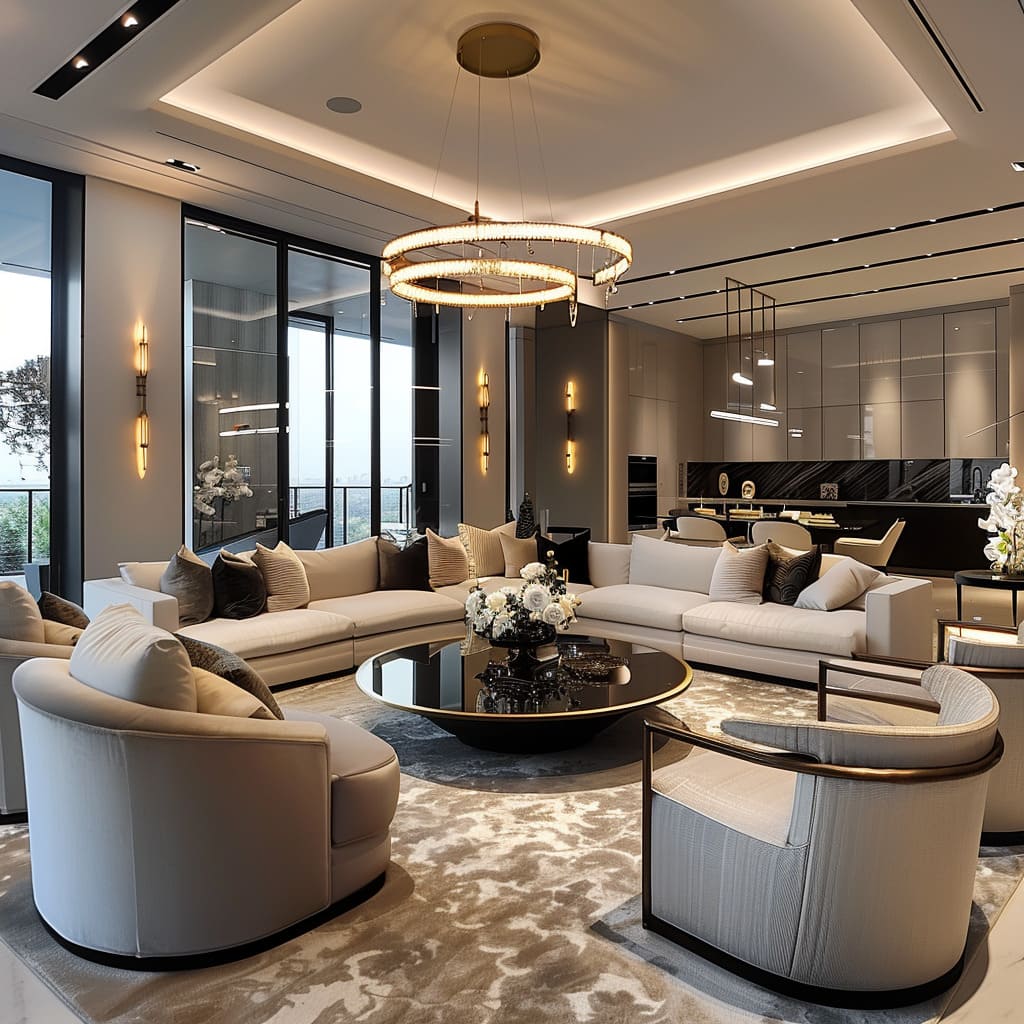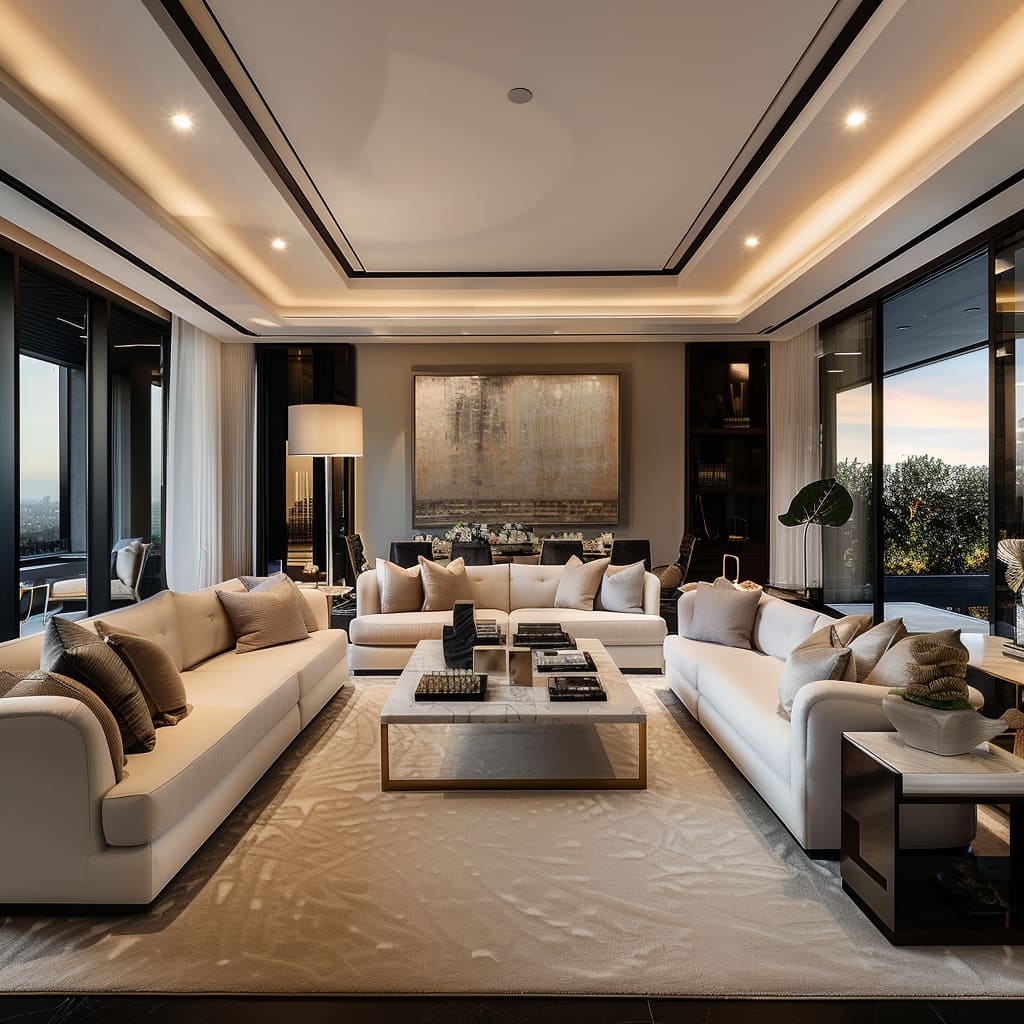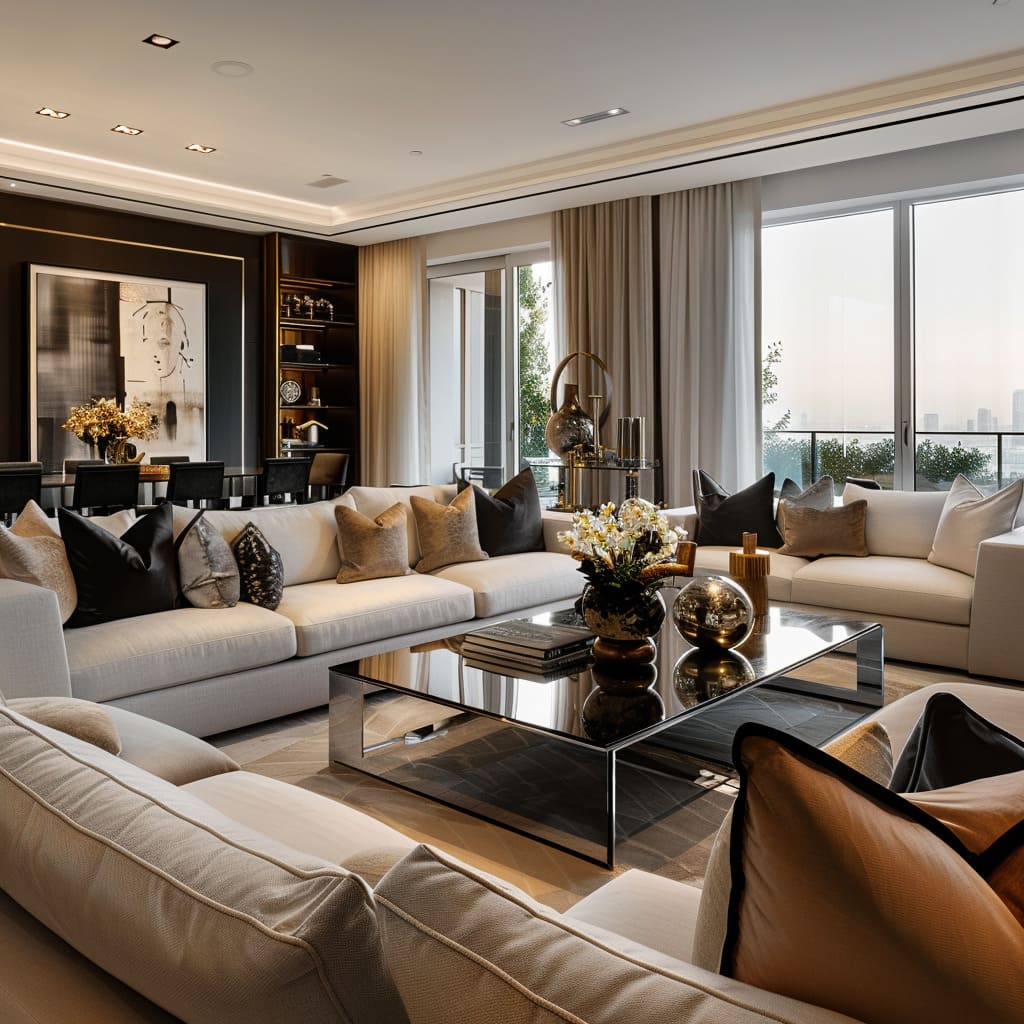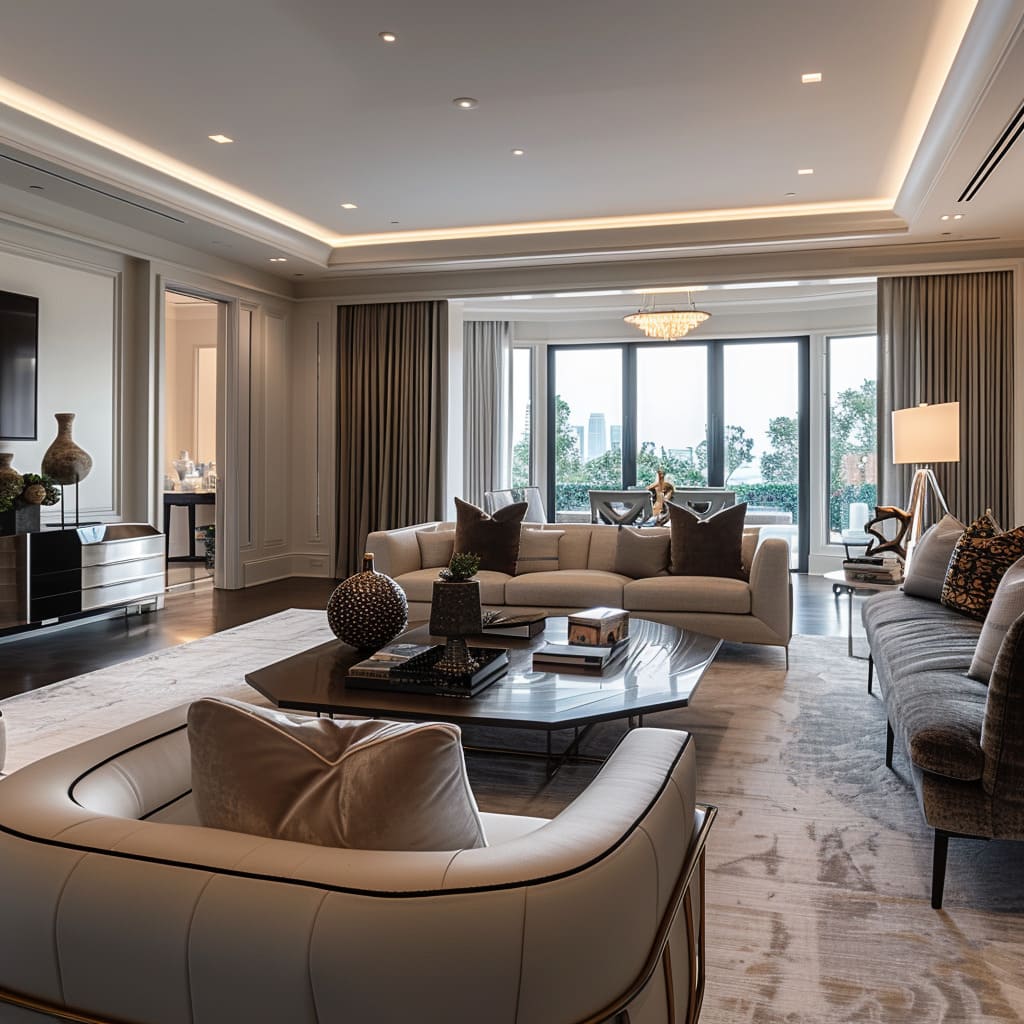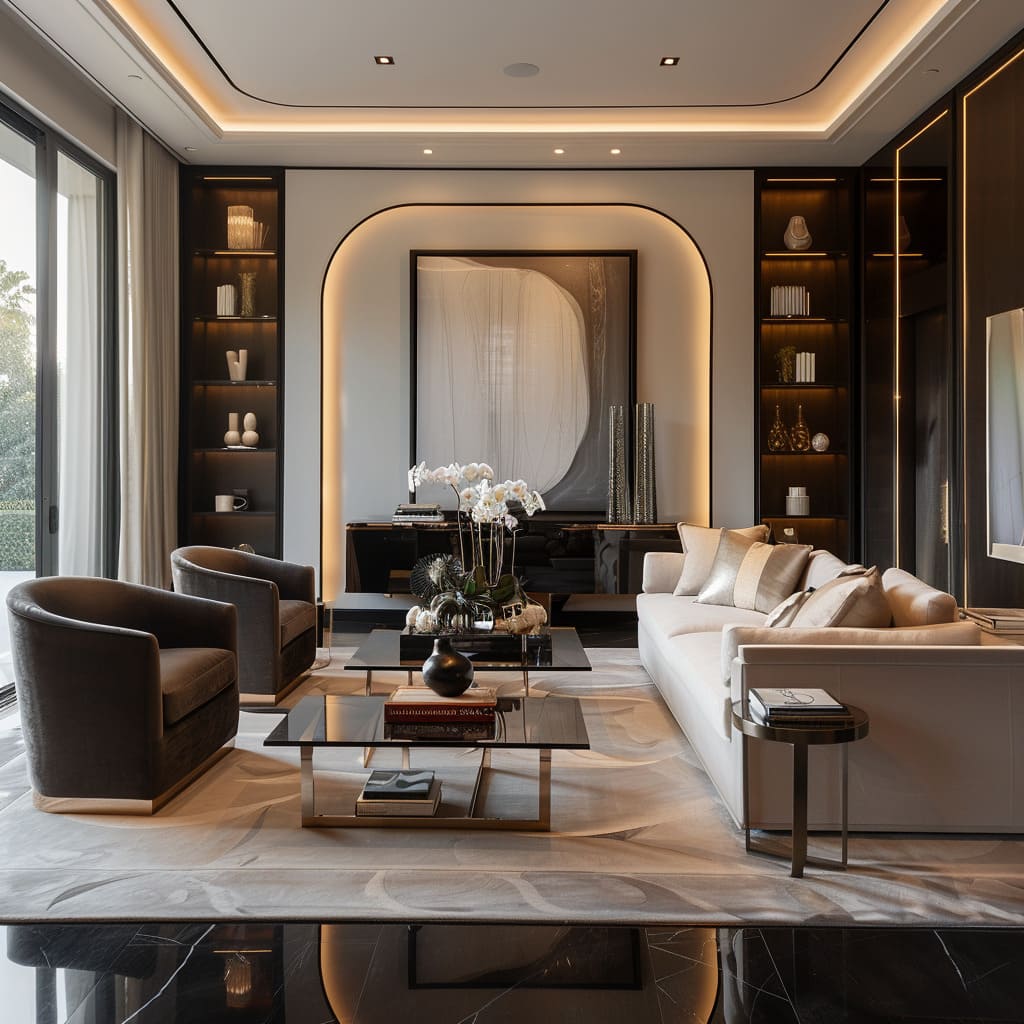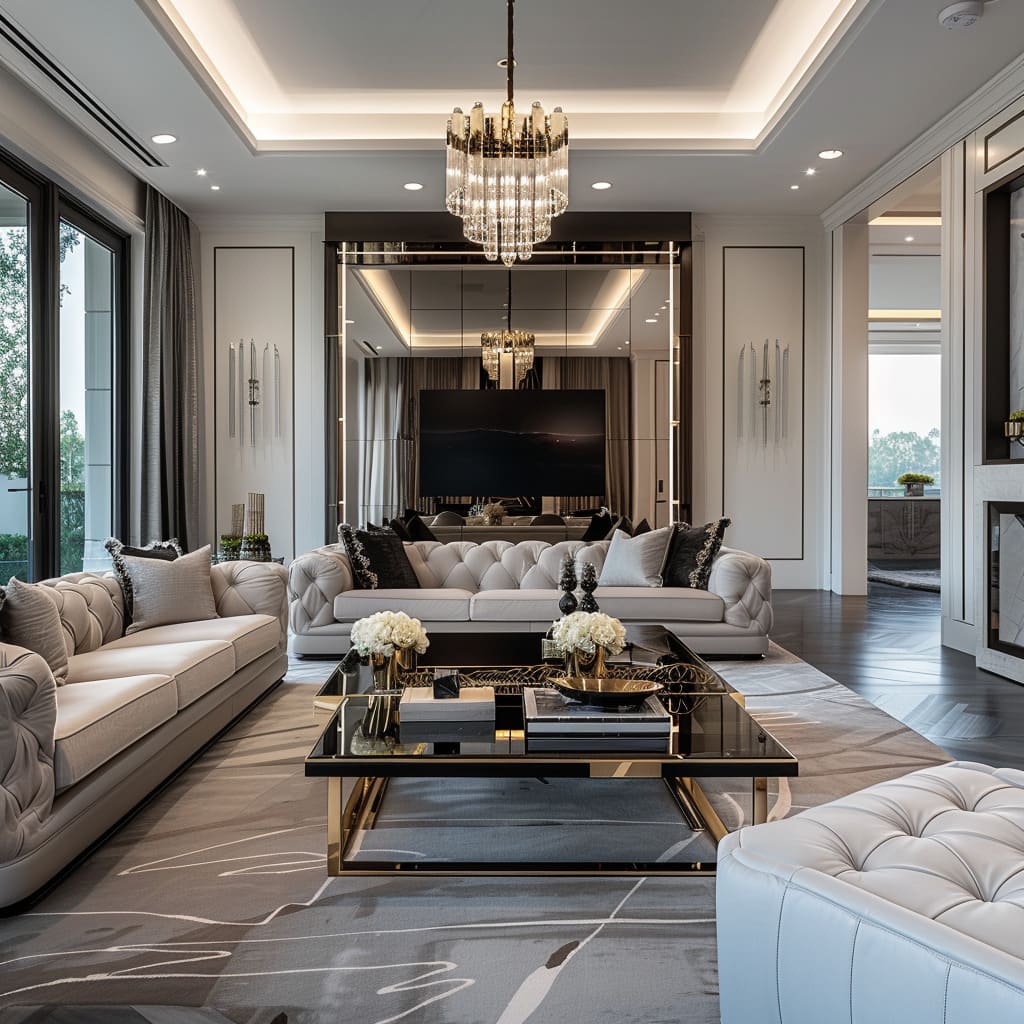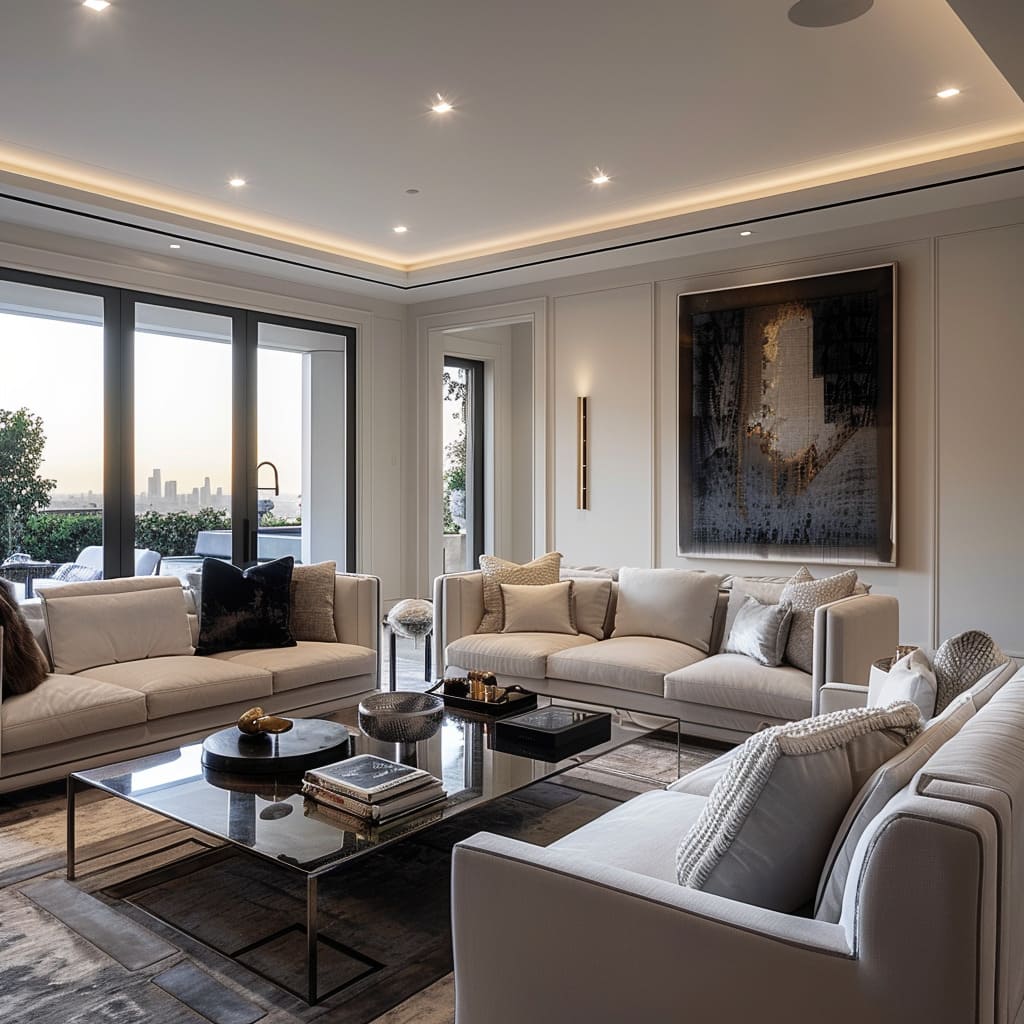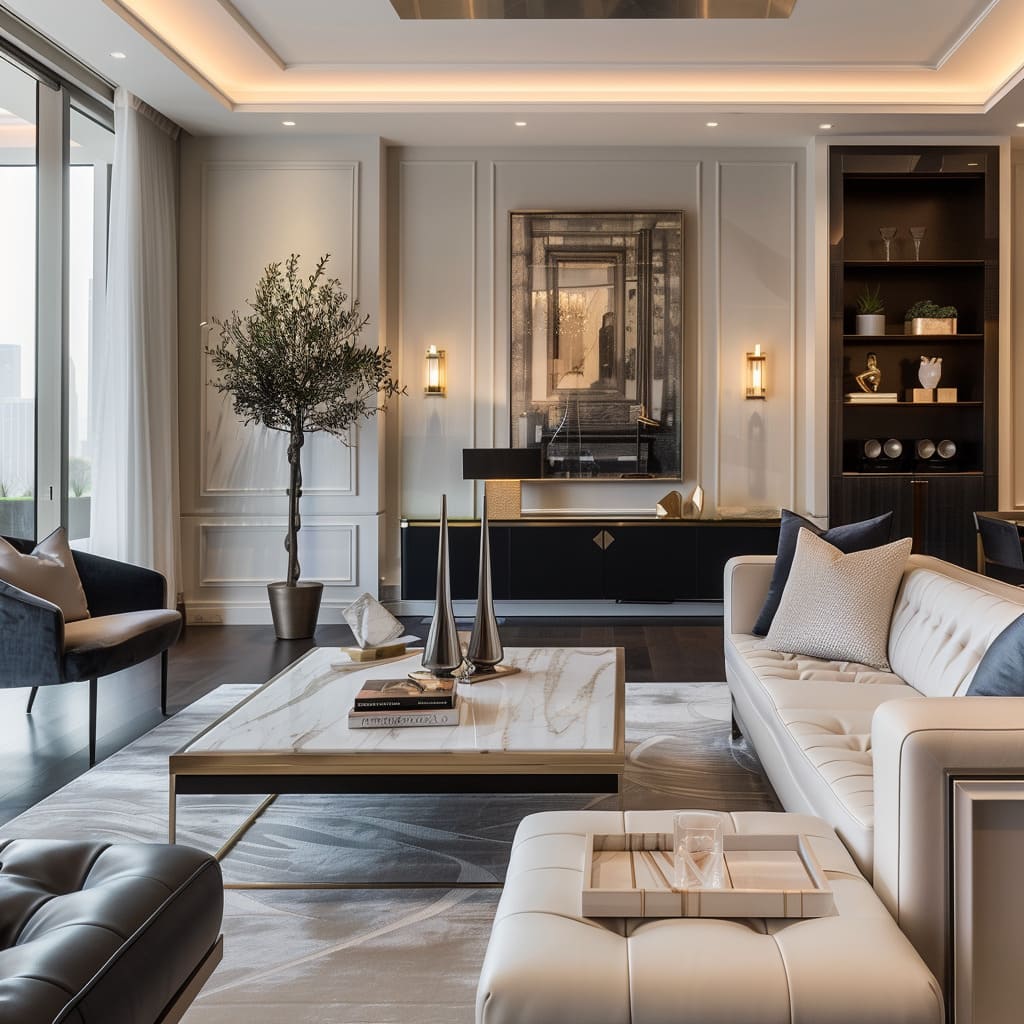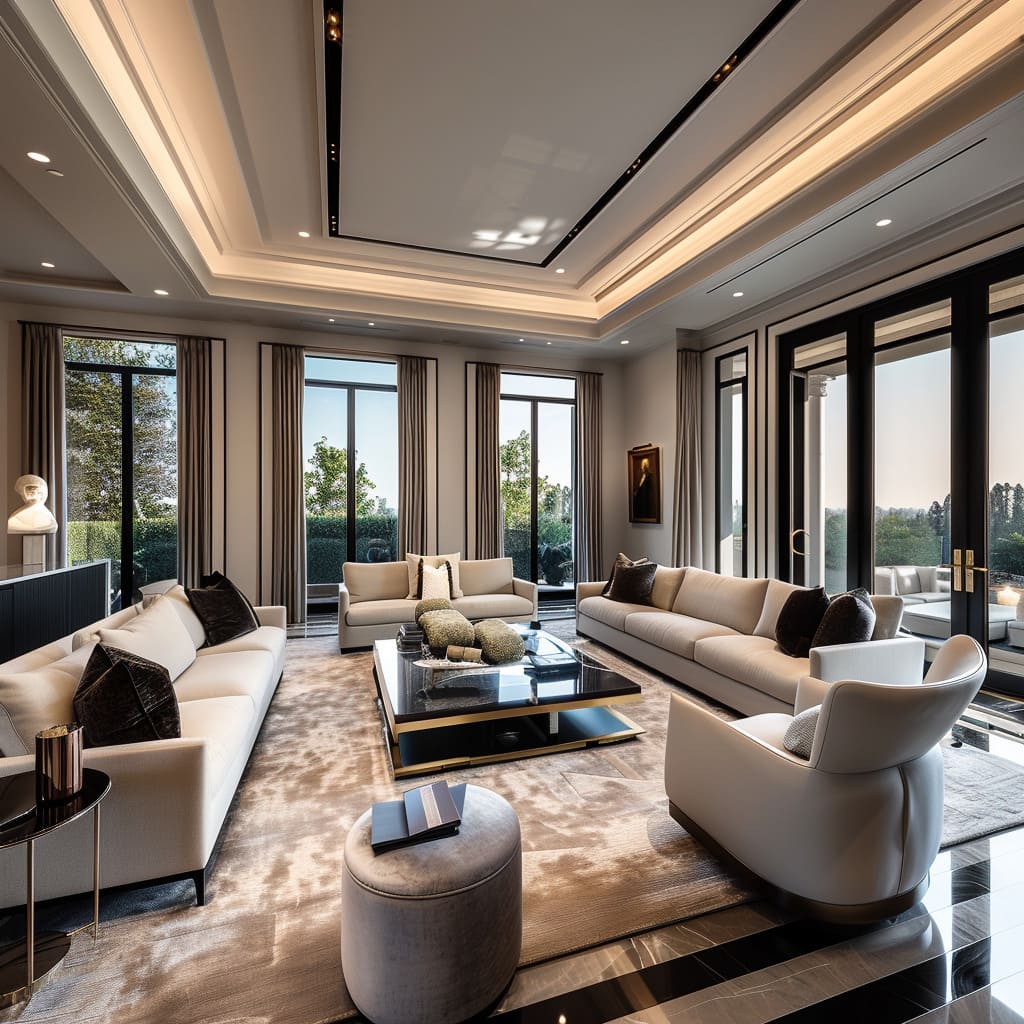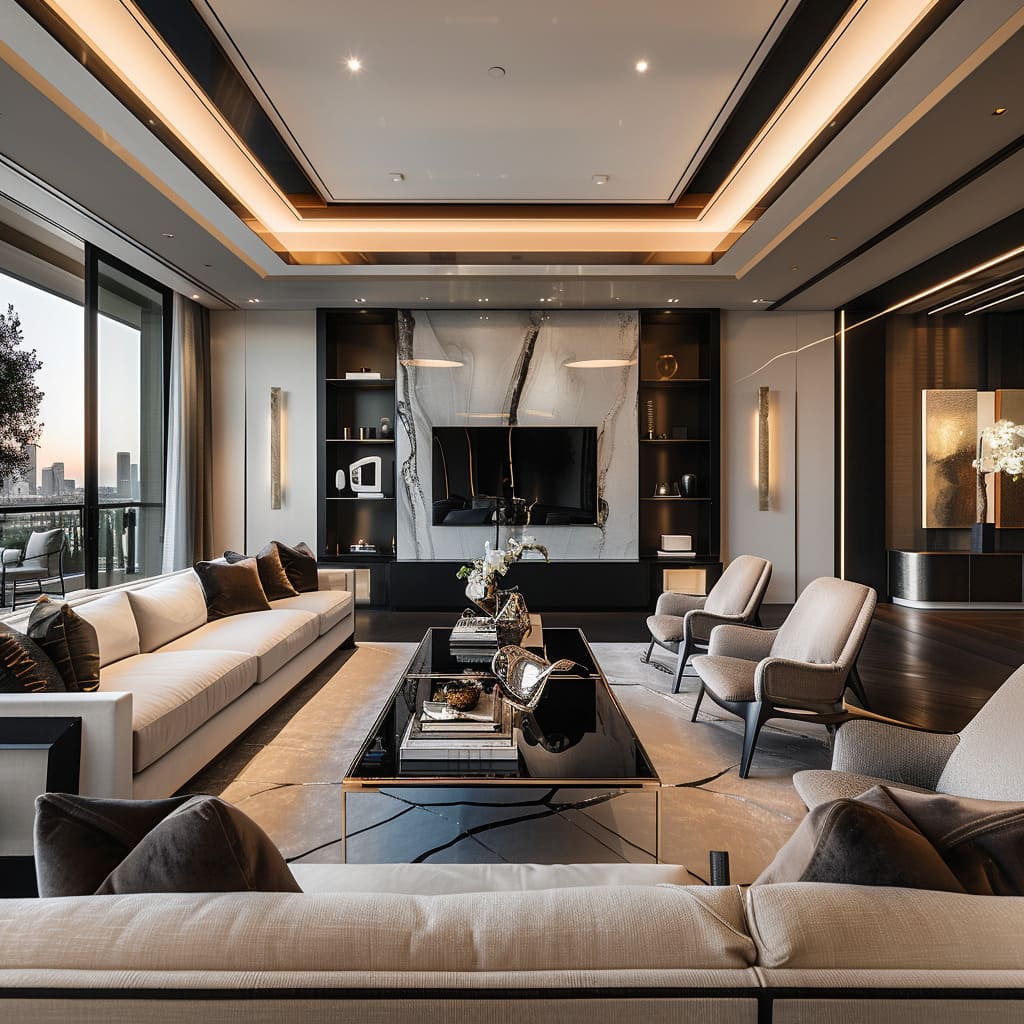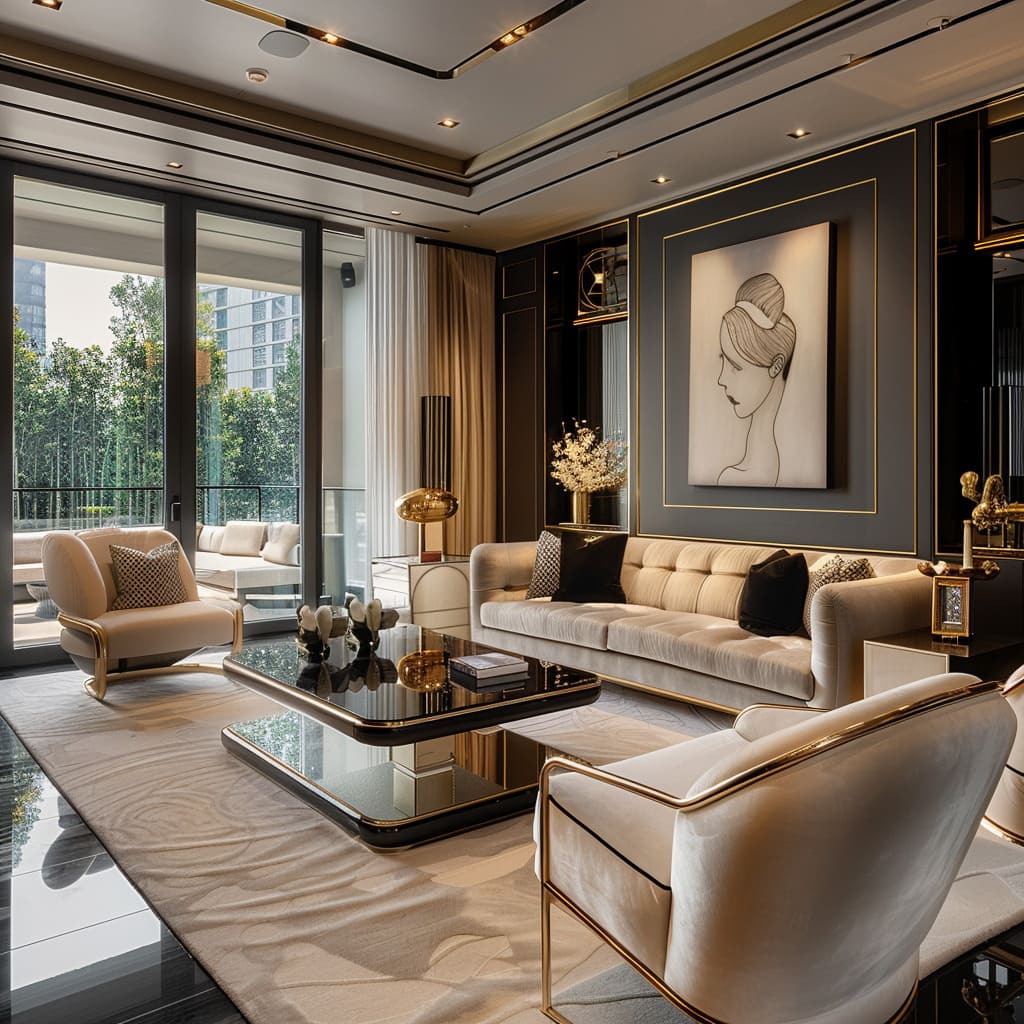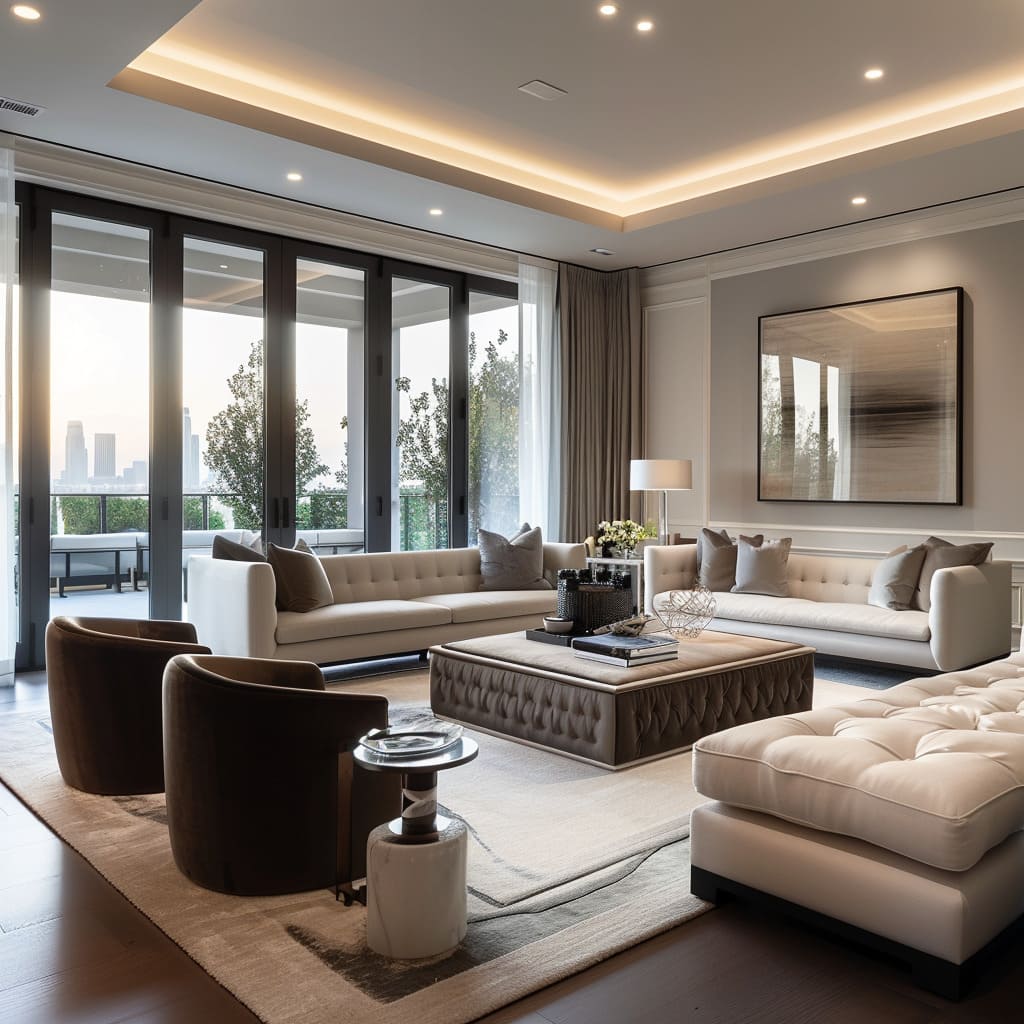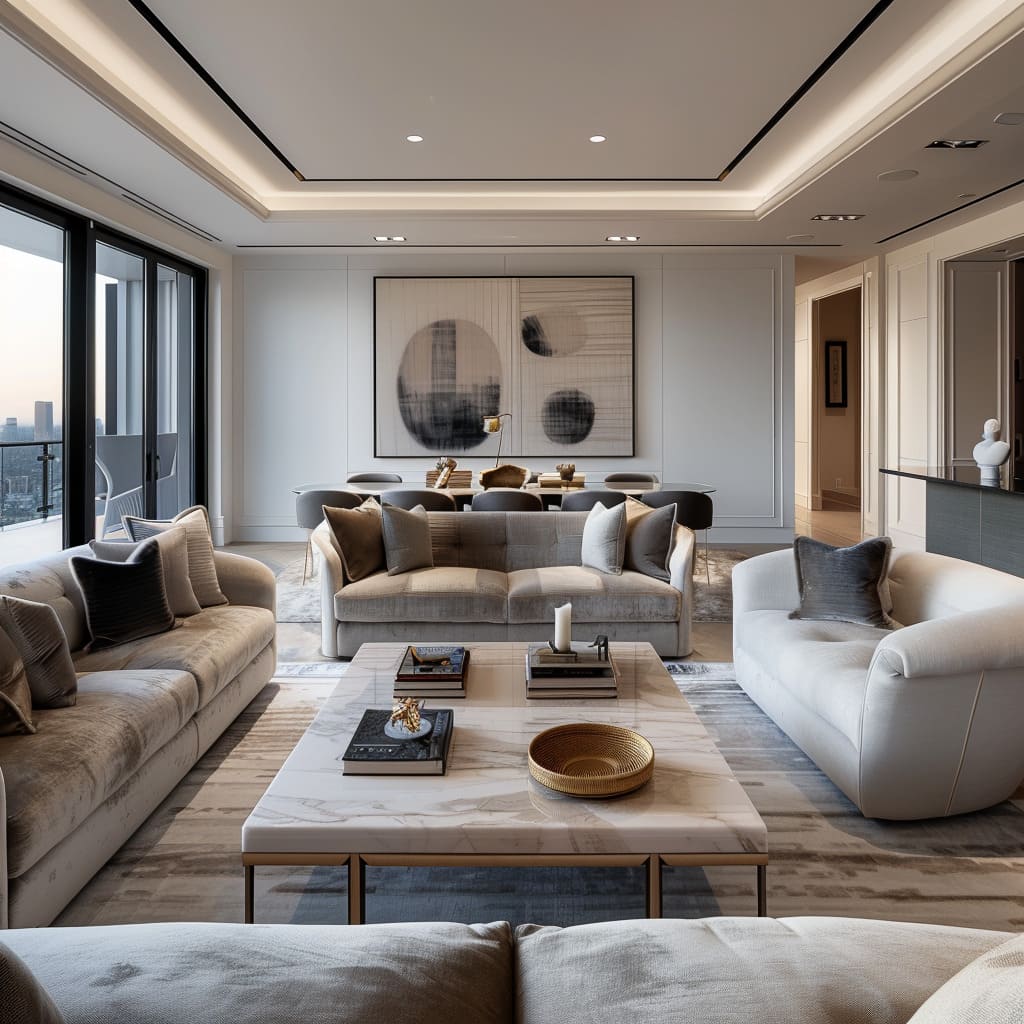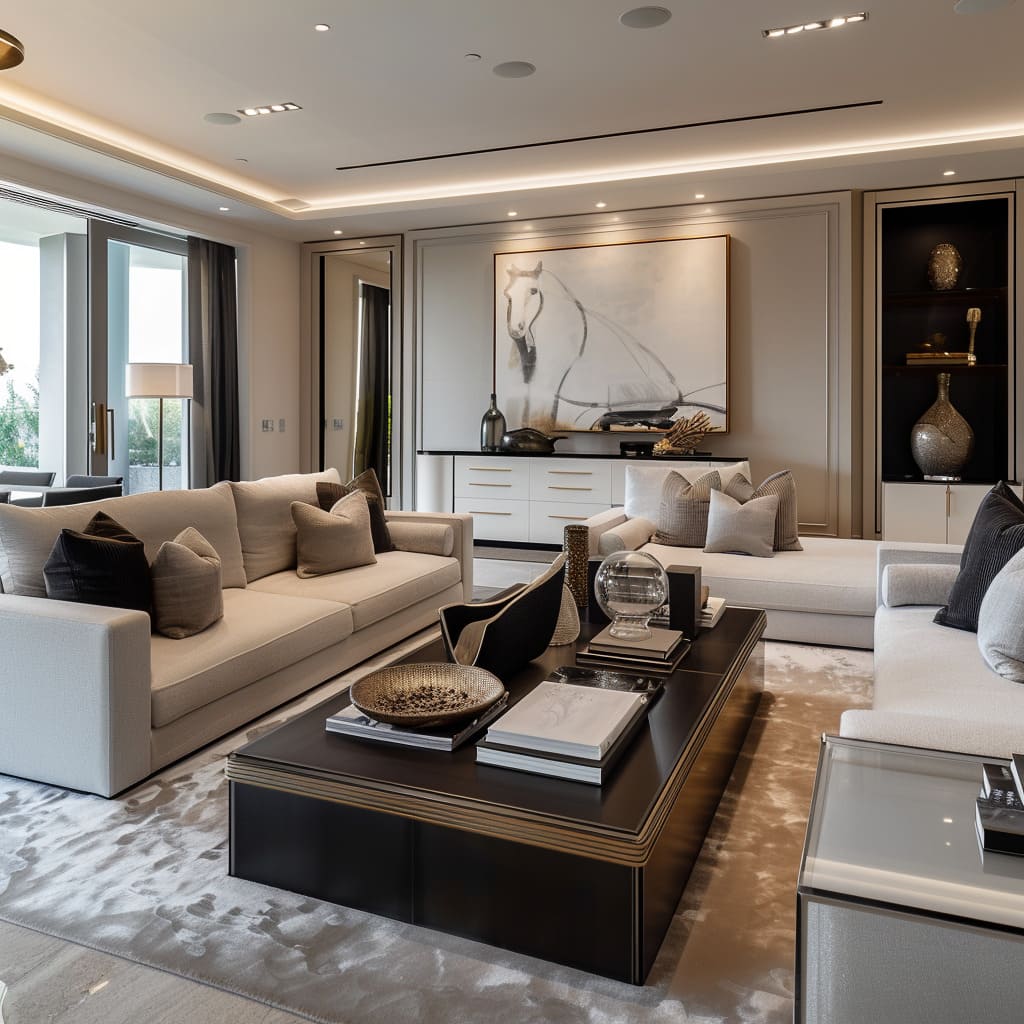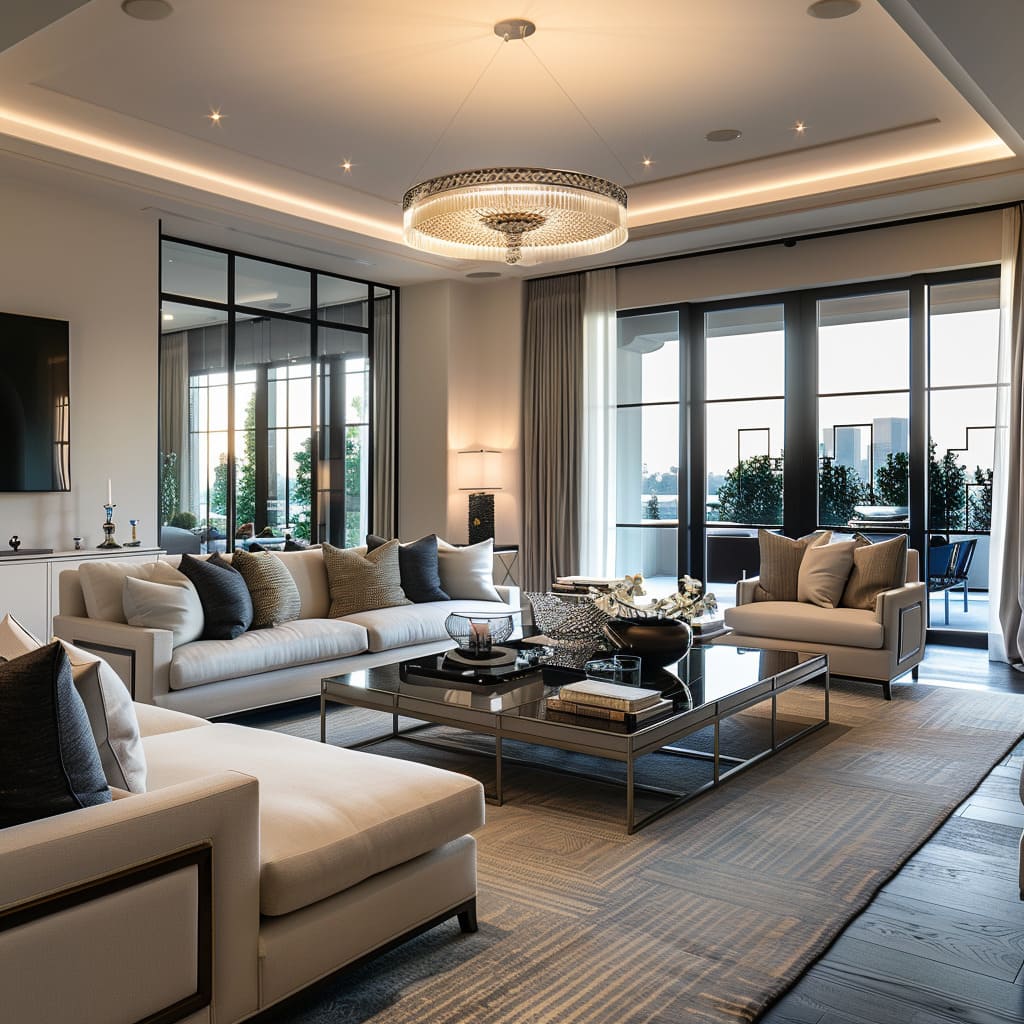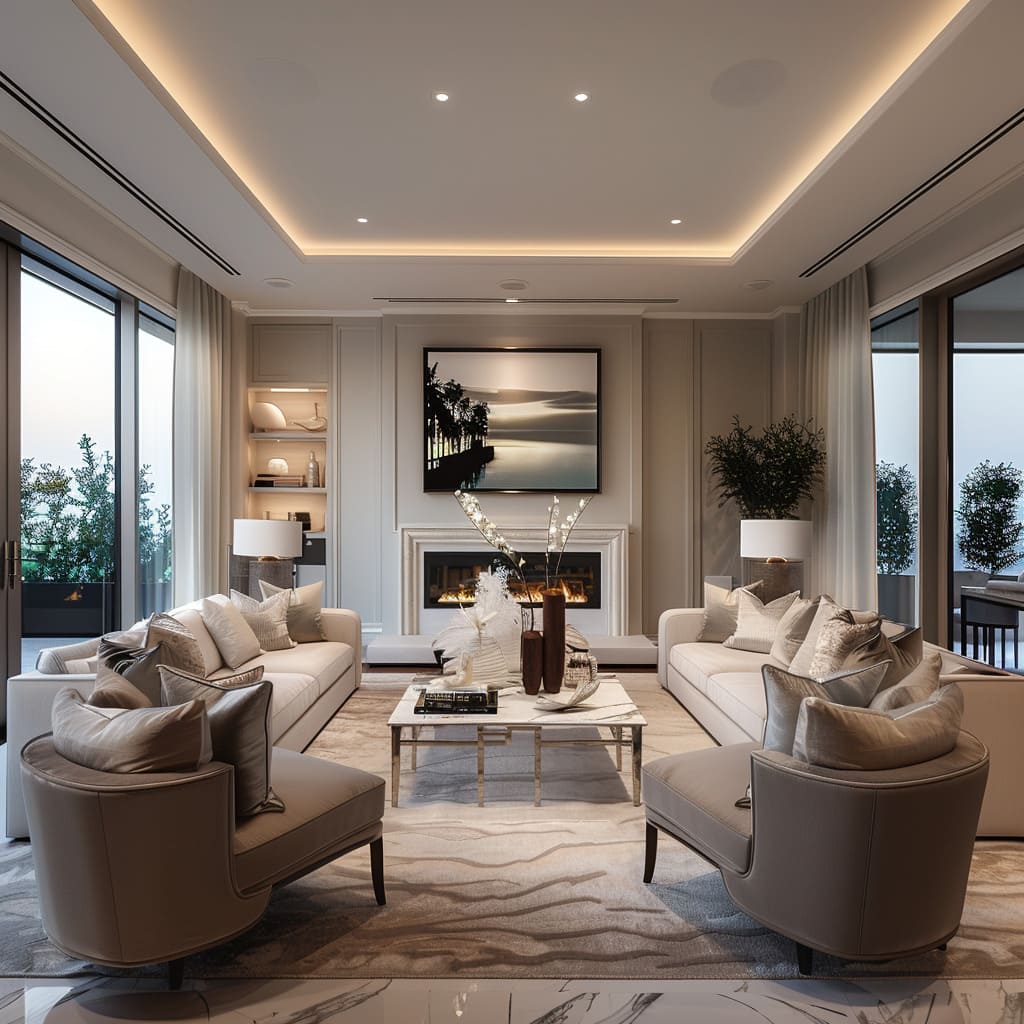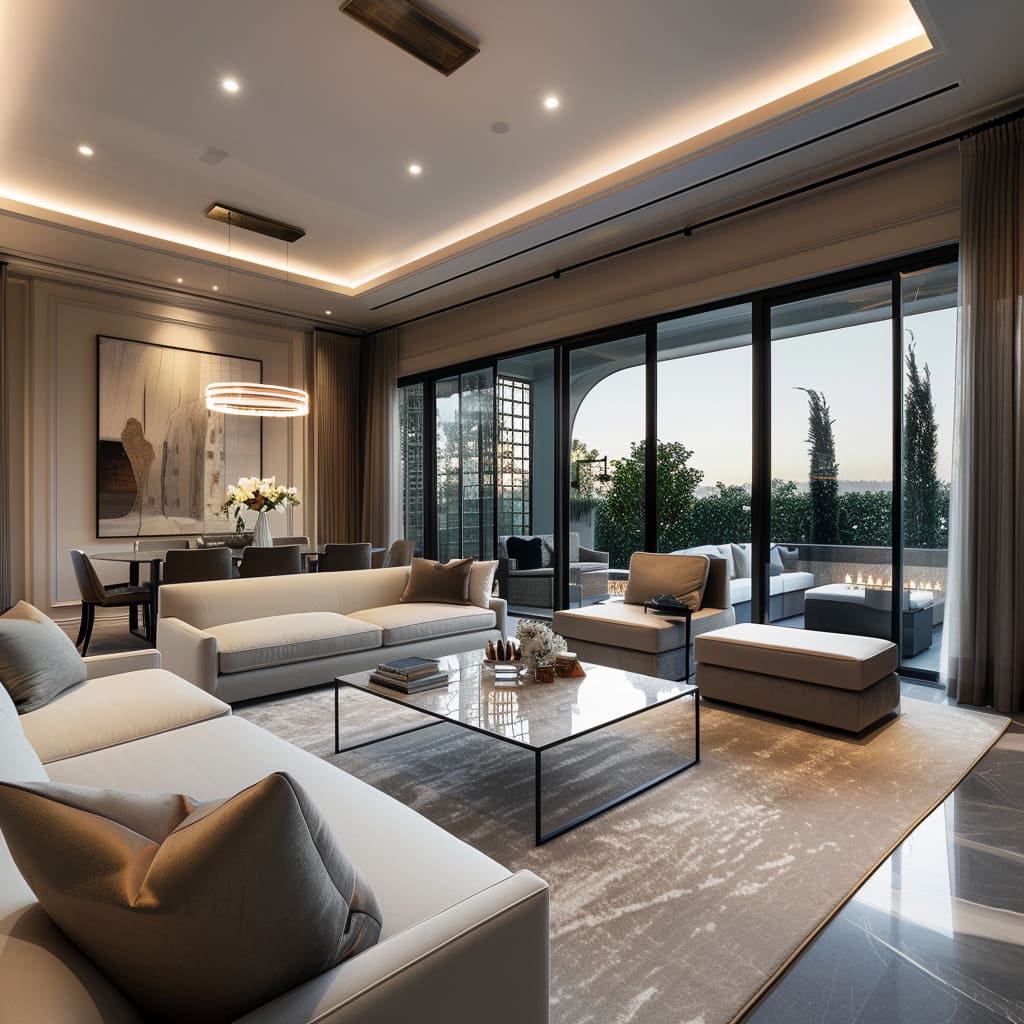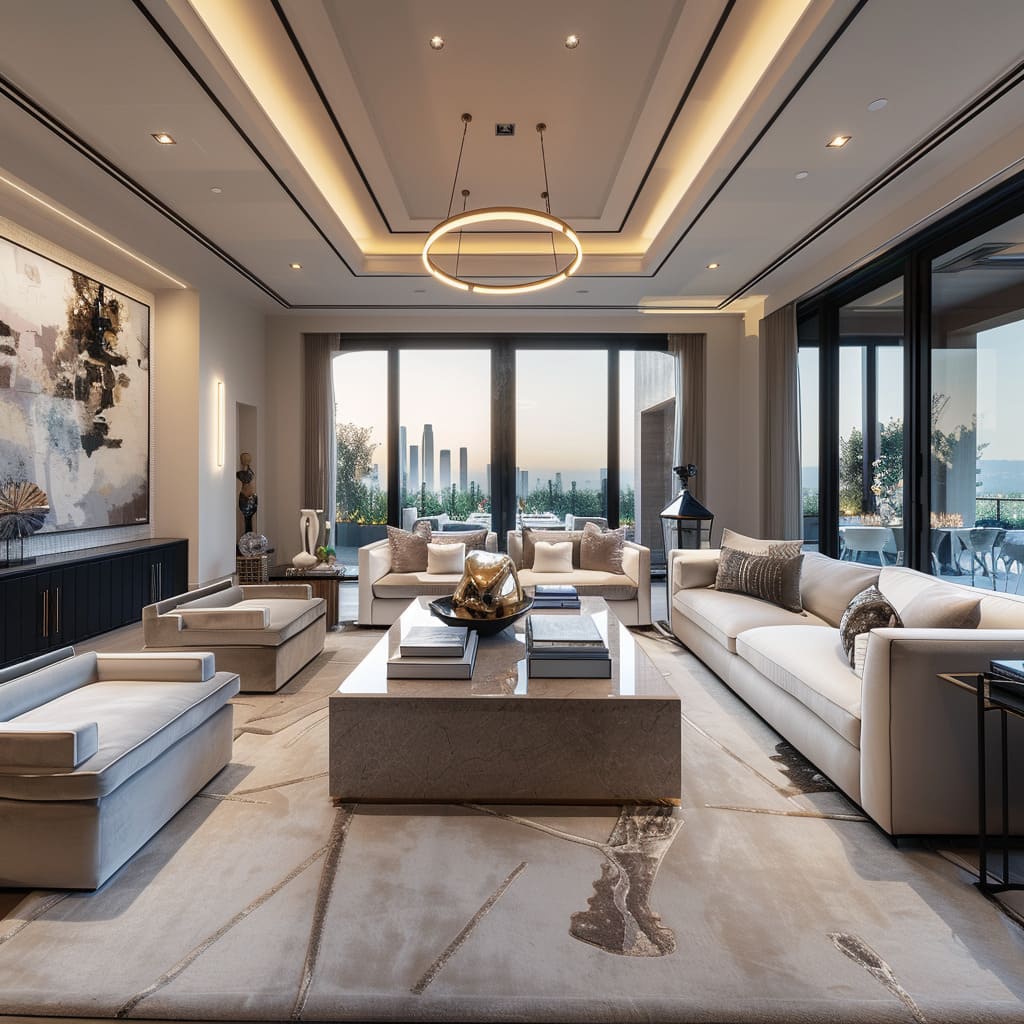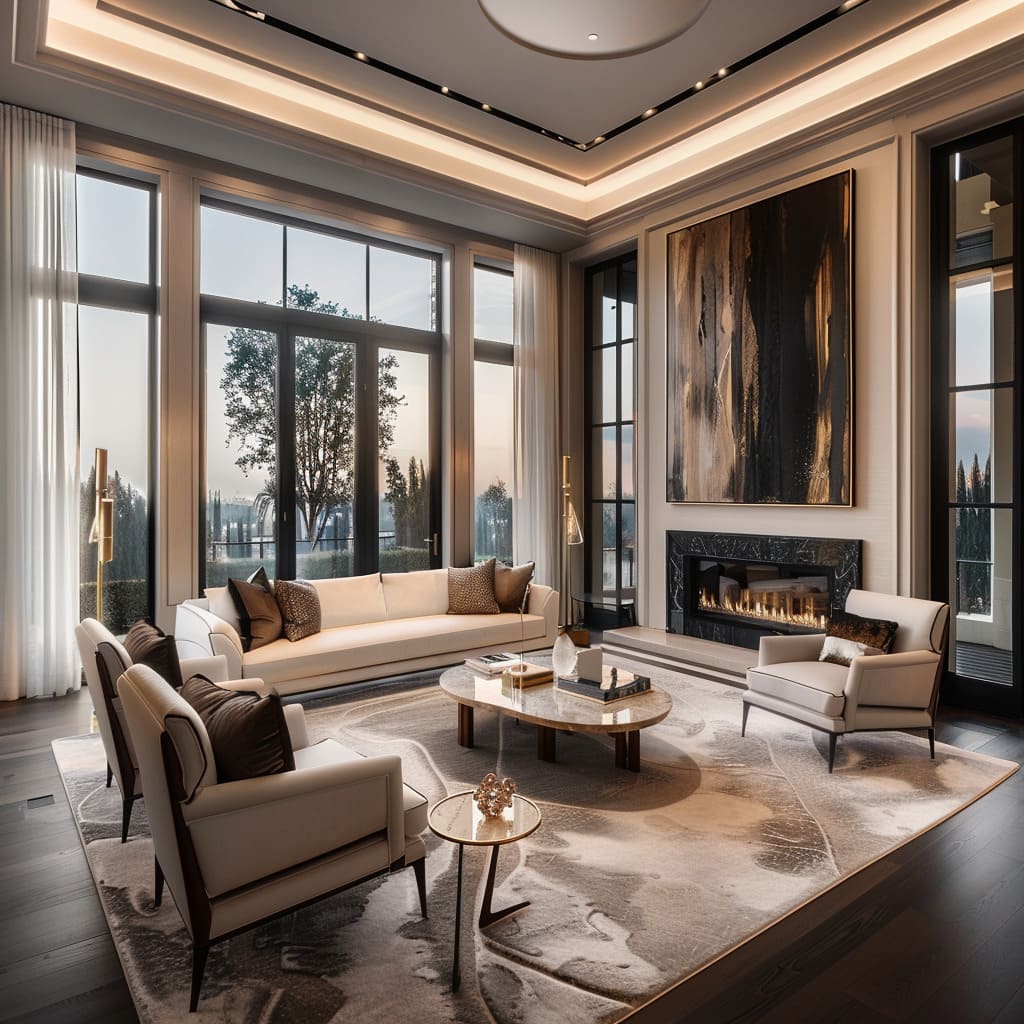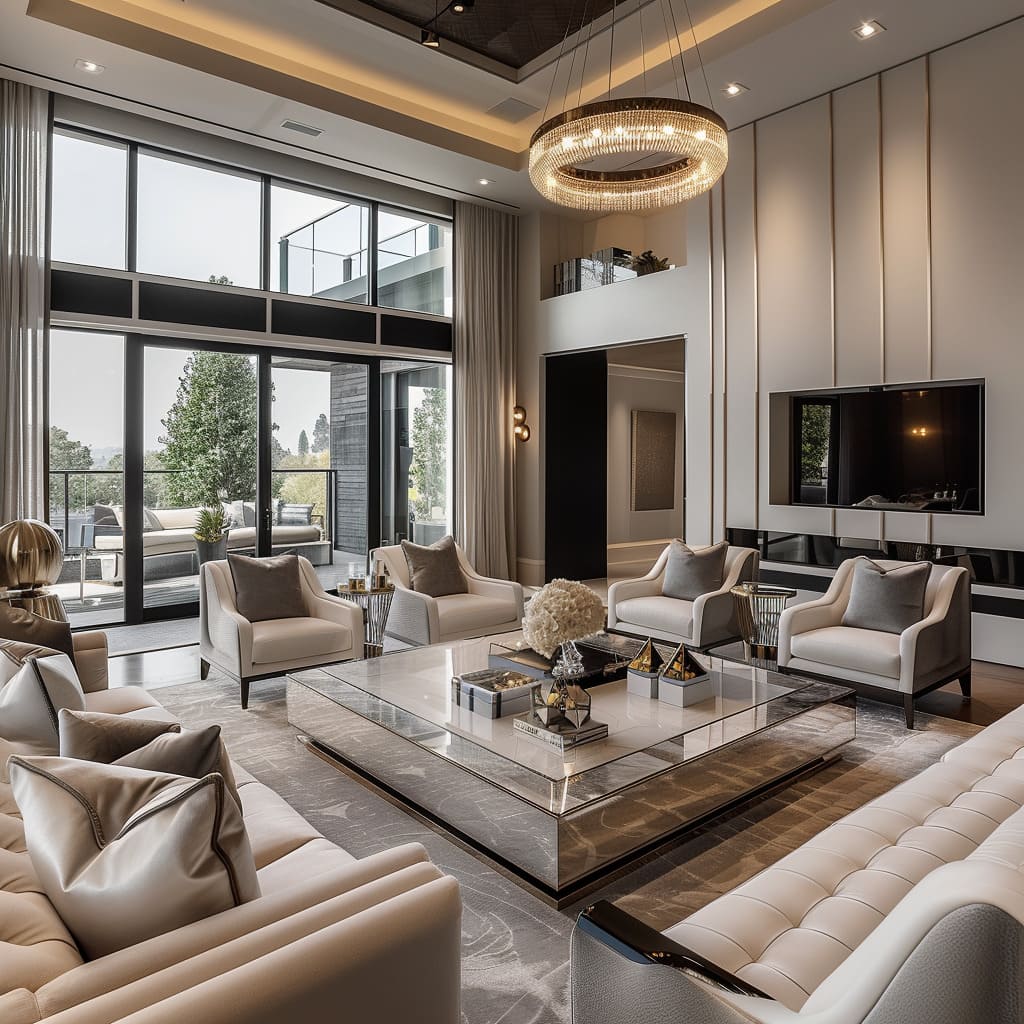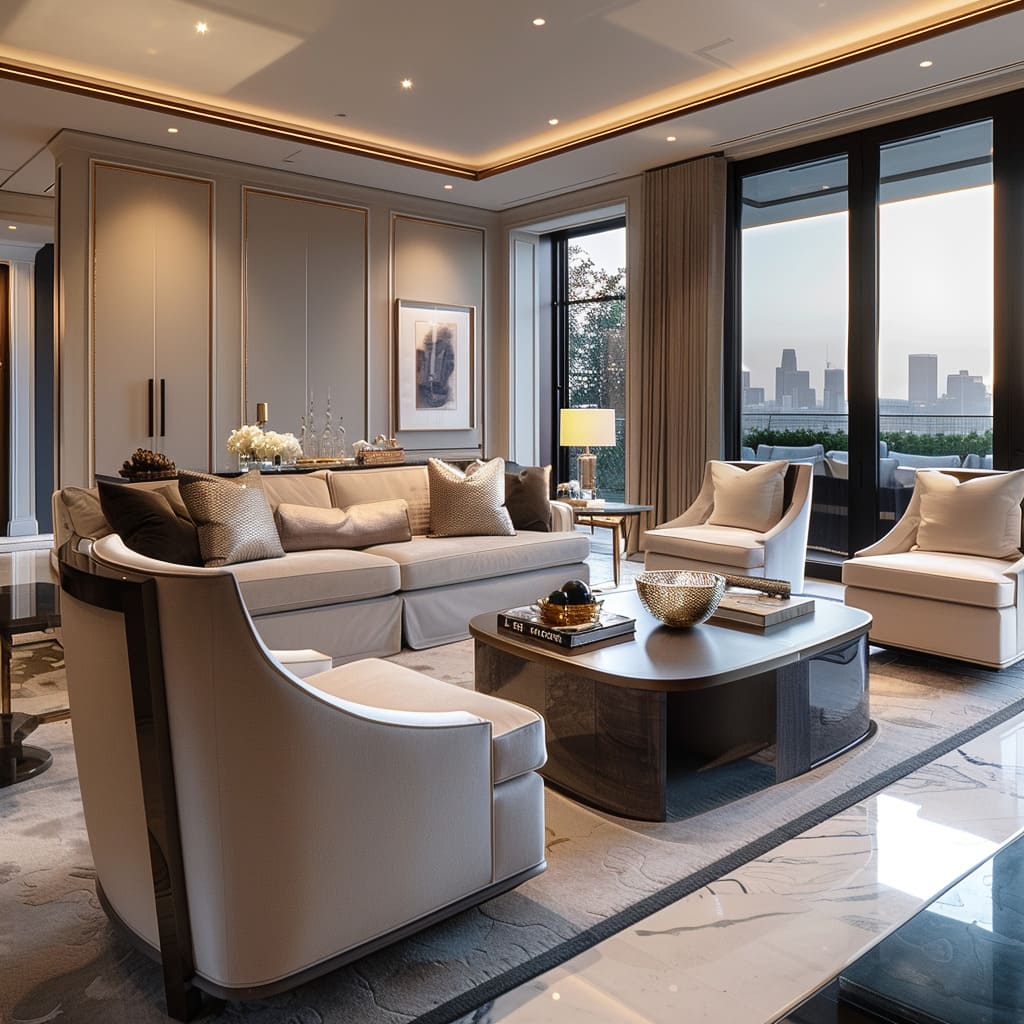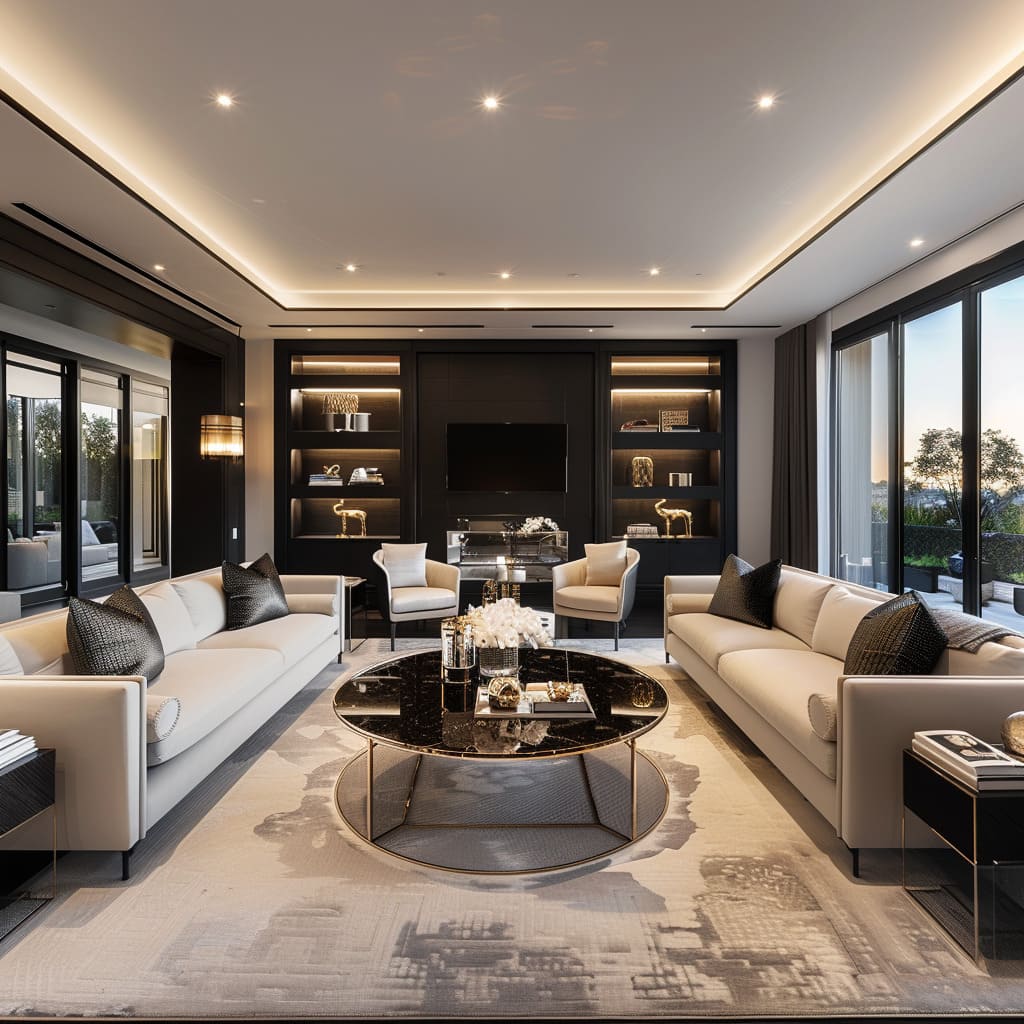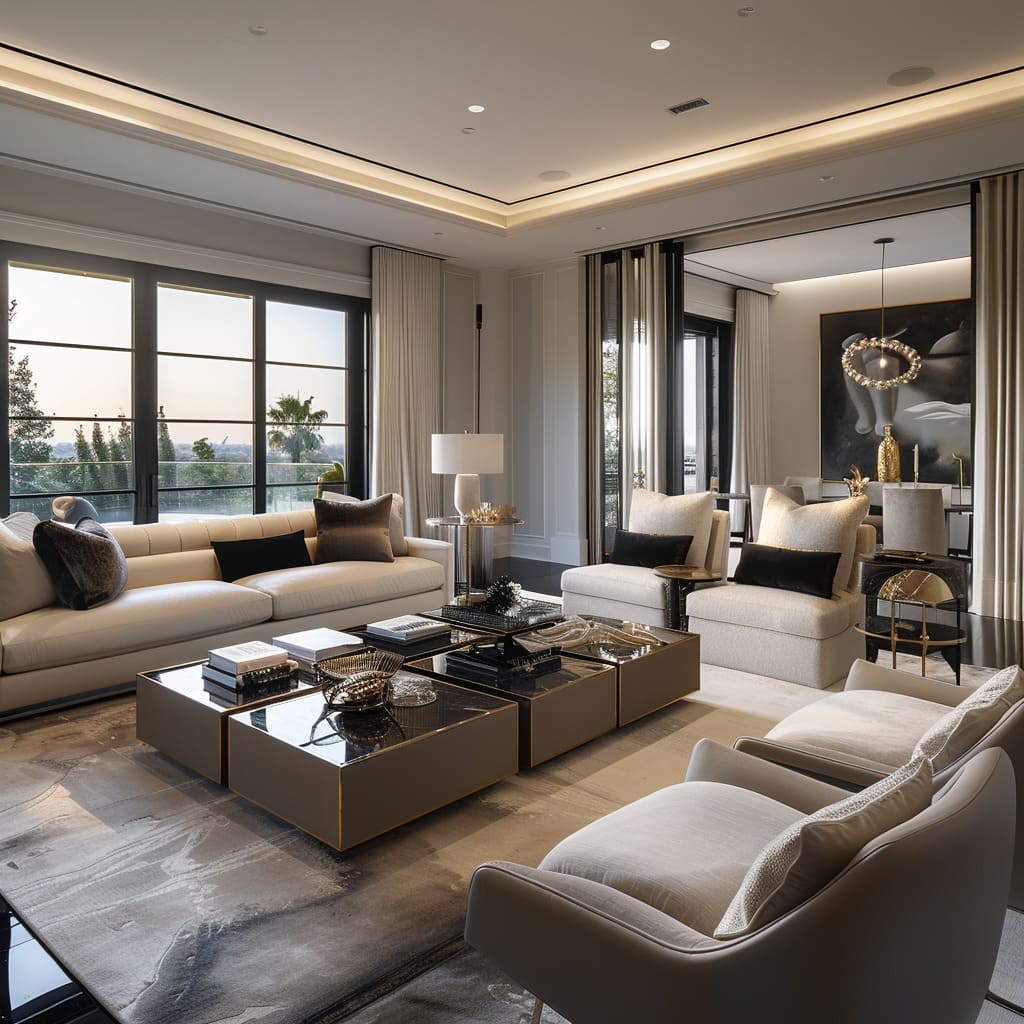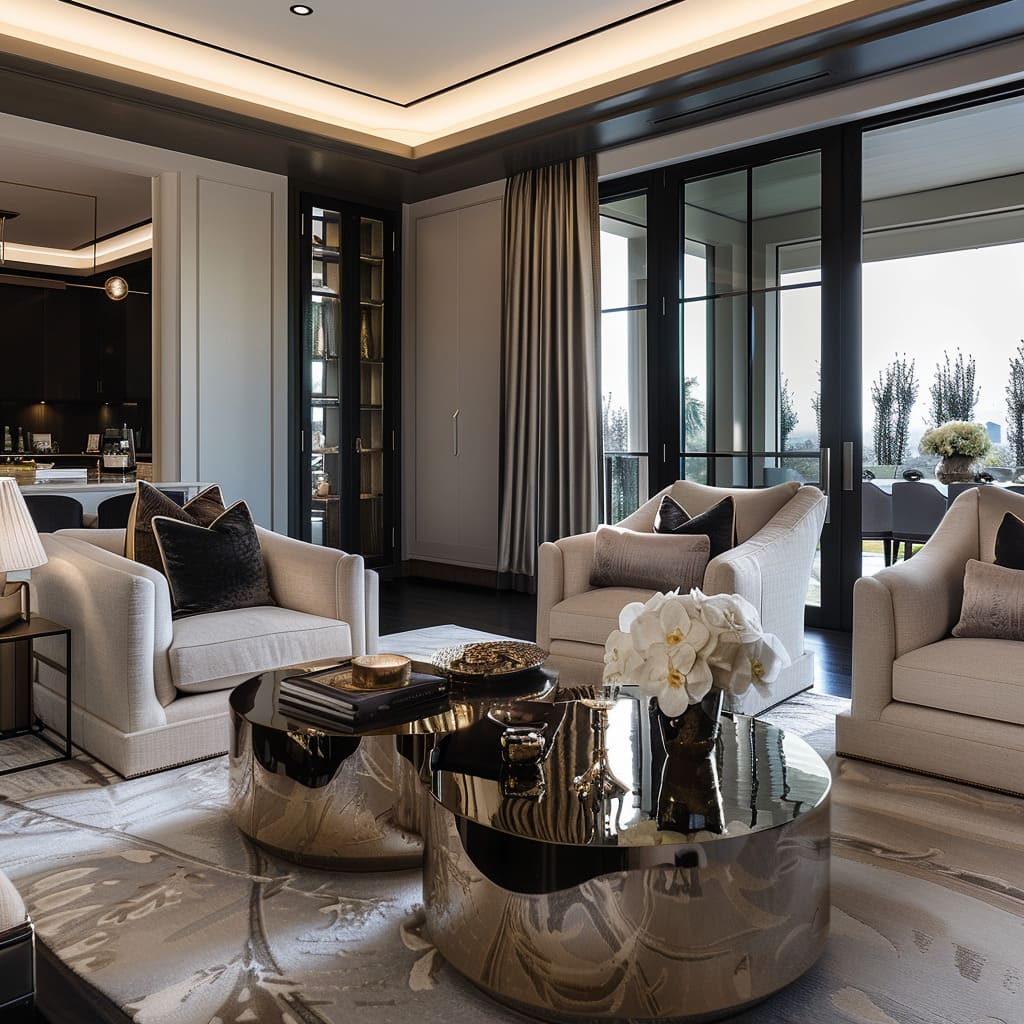In the nuanced world of interior design, the transitional style stands as a testament to elegance and a curator’s eye for detail. It’s a realm where luxury meets livability, classical elements fuse with contemporary insights, and every piece and placement speaks to both form and functionality.
This exploration into the transitional style isn’t just about admiring a series of well-curated designs; it’s an odyssey into the mastery behind them. We delve into the artistry of Architectural Enhancements that anchor a space, the Textural and Visual Dynamics that enliven it, the seamless Functional Aesthetics that modernize it, the selective Furnishing and Accents that enrich it, the meticulous Spatial Composition that defines it, and the clever use of Light and Transparency that illuminates it.
Each characteristic weaves into the next, creating a harmonious symphony of design that beckons one to look closer and appreciate the subtleties of a well-thought-out space.
Architectural Enhancements
Beyond mere furnishings, the true canvas of an interior space is its architecture. This section delves into the characteristics that leverage architectural elements to elevate the interior environment.
From Decorative Molding that adds classical gravitas to a room to Dynamic Ceiling Treatments and Varying Ceiling Heights that redefine the perceived volume of a space, these design choices embed luxury within the very structure of the room.
Decorative Molding
Intricate wall and ceiling moldings are a nod to classical architecture, infusing the space with a sense of history and artistry. These moldings are not merely decorative; they serve to frame the room, drawing the eye upward and creating a cohesive look that ties together the design elements.
Whether it’s the crisp lines of crown molding capping the walls or the elegant picture rails that provide a transition from wall to ceiling, each molding is meticulously chosen to complement the room’s aesthetic. Chair rails add a functional elegance, protecting walls from scuffs while also dividing the space visually, allowing for tasteful contrasts or a mix of wall treatments for added depth and interest.
Dynamic Ceiling Treatments
Ceilings receive as much design attention as the rest of the interiors, transforming them into a focal point rather than a forgotten plane. Through the use of architectural elements like tray ceilings, which recess upwards creating an inverted platform effect, there is a play of shadow and light that adds an airy grandeur to the room.
Paint treatments in subtle hues different from the walls can accent these recessed areas, enhancing the sense of depth and volume. Additionally, decorative beams may cross the expanse, providing both structural illusion and visual warmth, and where appropriate, ornate ceiling medallions can anchor statement lighting fixtures, further elevating the space’s design.
Varying Ceiling Heights
The strategic use of different ceiling heights can artfully delineate spaces within an open-plan design, ensuring that each area maintains its own character and ambiance. Higher ceilings might hover over living areas to foster an expansive, luxurious feel, while lower ceilings over dining or kitchen spaces can create intimacy and coziness.
This interplay of volume not only enriches the spatial experience but also allows for creative lighting solutions—such as hanging pendants or discreet track lighting—to further define and enhance these varied zones. The transitions between ceiling heights are smooth and intentional, contributing to the flow of the home while subtly marking the passage from one functional space to another.
Textural and Visual Dynamics
The interplay of textures and visual effects is crucial in creating an engaging and tactile experience within a space. This section explores the juxtaposition of different materials and the calculated use of light to achieve this effect.
Contrasting Textiles provide a sensory contrast, while Unique Textural Rugs and Inlaid Flooring offer underfoot luxury and design intrigue. Deliberate Shadow Play utilizes lighting to enhance the mood and dimensionality of the environment, inviting the eye to dance across surfaces and forms.
Contrasting Textiles
The intentional juxtaposition of textiles enhances the sensory appeal of the interiors. Luxuriously smooth fabrics on the main upholstery pieces create a sense of comfort and elegance, inviting touch and relaxation.
Against this backdrop, accent pillows feature rougher, more tactile textures such as bouclé or tweed, providing not only a contrast in feel but also adding visual interest and depth. This contrast is carefully curated to ensure harmony within the space, with textures chosen to complement rather than compete with one another.
Even within a single piece, such as a throw blanket, one might find a variety of textures, from a smooth, silky underside to a richly woven top that invites the hands to explore the surface.
Unique Textural Rugs
Rugs within the space are chosen for their distinctive textures and patterns, acting as both artwork for the floor and a unifying base for the furniture that rests upon them. These rugs can vary from hand-knotted wool, which adds warmth and richness, to natural fiber weaves that provide an organic, earthy foundation.
The patterns can range from bold, geometric shapes that give a contemporary edge to more traditional, intricate designs that speak to time-honored craftsmanship. The rugs are more than mere accessories; they are integral to the design, guiding color schemes and influencing the selection of adjacent textiles and finishes.
Inlaid Flooring
The flooring in these spaces goes beyond the utilitarian, becoming a key design feature through the use of intricate inlays. Wood floors might feature herringbone patterns or borders of contrasting wood species, while stone or tile floors could present elaborate mosaics or medallions.
This inlay work is not just flooring; it is a statement of luxury and attention to detail that sets the tone for the entire space. The intricate patterns draw the eye down, grounding the space and giving it a sense of place and permanence.
Such detail ensures that the flooring isn’t just a surface to walk upon—it’s a testament to design sophistication and elegance.
Deliberate Shadow Play
The use of light and shadow within the spaces is masterfully orchestrated to add a dramatic, dynamic quality to the environment. Strategic placement of lighting fixtures creates intentional shadows that can highlight architectural features, create visual interest, or convey a mood.
For instance, wall sconces might cast a gentle glow that washes over a textured wall, bringing out the intricacies of its surface. Recessed ceiling lights can create soft pools of light, adding depth and highlighting the furniture below.
Even natural light is considered, with window treatments designed to control the play of light and shadow across the room throughout the day. This deliberate shadow play is a subtle art that contributes significantly to the ambiance and character of the space.
Functional Aesthetics
Functionality need not come at the expense of beauty. This section focuses on the seamless fusion of utility and design, where each element serves a purpose while contributing to the overall aesthetic.
Custom Carpentry provides personalized storage solutions, and Distinctive Door Hardware offers practicality without foregoing style. The Artistic Integration of Multimedia ensures that modern technology complements the décor, maintaining the integrity of the design narrative.
Custom Carpentry
The art of custom carpentry is evident in the precision-fitted built-in shelving and cabinetry that adorns the space, designed not only for seamless utility but also to elevate the overall decor. These pieces are crafted from materials chosen to match or complement the room’s color palette and texture, making them an integral part of the design.
The shelving offers a display for curated books, decorative objects, and art pieces, while the cabinetry provides concealed storage, keeping the space uncluttered and stylish.
The craftsmanship is meticulous, with attention to the grain of the wood, the smoothness of the finish, and the subtlety of the joinery, all of which denote a space that is both functional and aesthetically pleasing. Moreover, the carpentry often features innovative touches such as hidden compartments or soft-closing mechanisms that marry form and function beautifully.
Distinctive Door Hardware
The door hardware within the space is far from ordinary, chosen for its distinctive design that complements the room’s unique style. Handles, knobs, and levers are not merely functional components but are selected with an eye for detail and luxury.
They may feature brushed or polished finishes, intricate embossing, or even a patina that adds character. The hardware acts as jewelry for the doors, enhancing both the tactile experience of entering a room and contributing to the room’s visual appeal.
Such hardware is often custom-made or selected from designer collections, ensuring that even the smallest elements are in line with the bespoke nature of the home’s design ethos.
Artistic Integration of Multimedia
In this modern age, multimedia elements are a fundamental part of living spaces, but in these interiors, they are incorporated artistically to blend with the room’s aesthetic. Televisions and screens are thoughtfully placed to ensure they do not interrupt the design narrative.
They may be framed with custom cabinetry that aligns with the surrounding decor or hidden behind panels that display artwork when not in use. This approach ensures that when the screens are off, they contribute to the room’s beauty, and when on, they serve their purpose without dominating the space.
This integration speaks to a sophisticated design philosophy where technology complements lifestyle without sacrificing the cohesive visual flow of the room.
Furnishing and Accents
Furnishings and decorative accents are the jewels of interior design, offering both comfort and splendor. In this section, we look at how Rounded Edges on Furnishings, Striking Floor Lamps, and Curated Accessory Groupings come together to furnish a space that is as inviting as it is luxurious.
Each piece is selected not just for its function but for its contribution to the overall harmony and elegance of the room.
Rounded Edges on Furnishings
Furnishings throughout the space abandon sharp angles for the gentle curves of rounded edges, introducing a softness and flow to the interiors. This choice in design not only contributes to a welcoming and comfortable ambiance but also reflects a contemporary aesthetic where smooth lines prevail.
The rounded edges can be found in various pieces, from the central coffee table to side tables, and even the armchairs and sofas that beckon with their embracing forms. These curves are echoed in the room’s architecture, such as in arched doorways or rounded alcoves, creating a consistent and harmonious flow throughout the space.
The preference for rounded furniture edges also enhances safety, reducing the likelihood of bumps or scratches, a consideration that marries the practical with the stylish.
Striking Floor Lamps
Floor lamps in the room rise up like statues, their forms as carefully considered as any piece of artwork in the space. They range in style from minimalist poles with a single glowing orb to more elaborate, branching structures that spread light across the room.
The design of each lamp is chosen to complement the room’s overall theme, with materials and colors that echo other elements in the space, such as metallic finishes that match door handles or fabric shades that coordinate with the upholstery. These lamps are positioned to not only illuminate dark corners but also to create visual landmarks in the room, often placed beside a reading chair or framing a sofa, they enhance the room’s ambiance and functionality.
Curated Accessory Groupings
Accessories are not scattered haphazardly but are thoughtfully arranged in groupings that tell a story or create a moment of visual interest. Often arranged in odd numbers, such as trios or quintets, these groupings adhere to principles of balance and asymmetry that catch the eye.
Vases, books, and sculptural objects are chosen for their complementary colors, textures, and sizes, and are placed on mantles, shelves, and tables to draw attention or create a focal point. The placement of these items is deliberate, with taller items at the back and smaller ones in front, allowing each piece to be seen and appreciated.
This careful curation of accessories reflects a layered approach to design, where every item has a purpose and adds to the room’s rich tapestry of textures and stories.
Spatial Composition
The organization of space is an art form in itself, guiding movement and sightlines within an interior. This segment examines the strategic placement of elements to shape the experience of the space.
Intentional Asymmetry adds intrigue to balance, Accentuated Vistas direct focus to intended views, and Zoning with Area Rugs subtly delineates different functional areas within an open space, showcasing a masterful orchestration of the interior landscape.
Intentional Asymmetry
Asymmetry is strategically employed within these spaces to create a dynamic and intriguing environment. This purposeful imbalance engages the viewer, leading the eye across the room in a natural, flowing manner.
It’s evident in the positioning of furniture—perhaps a sofa paired with a single accent chair on one side and a set of nested tables on the other, or artwork displayed at varying heights to create an engaging gallery wall. The asymmetrical design is balanced by a cohesive color scheme and complementary materials, ensuring a cohesive look despite the unconventional layouts.
This approach to asymmetry brings an element of surprise and sophistication, offering a fresh take on space that encourages movement and interaction.
Accentuated Vistas
The careful placement of furniture and decorative elements is designed to draw attention to the room’s best views, whether they be of the outdoors through large windows or of an adjacent room’s striking interior. Seating is arranged to face outward, maximizing the enjoyment of picturesque outdoor landscapes or cityscapes.
Within the room, the eye is drawn to architectural features or art pieces by the strategic positioning of lighting and furnishings that lead towards these highlights. This thoughtful arrangement not only maximizes the impact of the vistas but also enhances the sense of depth and dimension within the space, making the most of both the interior and exterior views.
Zoning with Area Rugs
In open-plan areas, the clever use of area rugs creates distinct zones without the need for walls or dividers, offering a sense of structure and intimacy within the larger space. Rugs act as anchors for groupings of furniture, delineating areas for dining, lounging, or conversation.
The rugs themselves are chosen not just for their size and shape but also for their color and pattern, which complement the function of each zone—lively patterns for active areas, softer textures for relaxation spaces. This method of zoning allows for fluid movement between areas while maintaining a sense of organization and purpose, subtly defining how the space is used and experienced without compromising the open feel of the layout.
Light and Transparency
Light is the invisible paintbrush of interior design, with the power to transform mood, perception, and spatial clarity. This section reveals how Statement Lighting, Elegant Drapery, and the Use of Glass to Enhance Space work in concert to control and manipulate light.
Together, they create an atmosphere that can range from the dramatic to the serene, highlighting the space’s best features and ensuring that light becomes a defining component of the overall design.
Statement Lighting
Lighting fixtures are handpicked not only for the luminescence they provide but also for their aesthetic presence. Whether it’s a bold chandelier that commands the center of a room, an artistic pendant light, or a series of sleek track lights, each fixture is a piece of art in itself.
Designers consider the scale, material, and silhouette of these pieces, ensuring they contribute to the space’s visual narrative. For instance, a cluster of pendant lights may mirror other circular motifs in the room, or a metallic finish might echo hardware details elsewhere.
The glow they cast is equally important, from the warm wash of a wall sconce to the bright spotlight of a task lamp, each contributing to the overall tapestry of light within the space.
Elegant Drapery
Drapery is far more than a window treatment; it’s a design element that can dramatically alter a room’s appearance. Floor-to-ceiling curtains frame windows and add vertical lines that draw the eye upwards, amplifying the perceived height of a space.
The material choice—be it sheer, linen, or heavy velvet—plays into the room’s textural dialogue, while the drape’s movement adds a layer of softness against static architectural forms. When closed, they act as a canvas for the interplay of light and shadow, while pulled back, they invite the outside in, enhancing the room’s depth and dimension.
Use of Glass to Enhance Space
The strategic use of glass in furnishings and decor opens up an interior, lending an almost ethereal quality to the spaces it inhabits. Glass dining tables, coffee tables, and even shelves maintain the visual flow of a room without the heaviness of solid materials.
This transparency means that natural and artificial light can traverse freely, creating a sense of expansiveness and openness. Glass decor, like vases and sculptures, catches and refracts light, contributing to an ever-changing play of brightness and shadow that gives the room life and vibrancy.
The material’s reflective quality also serves to bounce light around a room, further enhancing the feeling of spaciousness.
In conclusion, the transitional interior design is an artful interplay of many distinct features working cohesively to form spaces that are as comfortable as they are stunning. The true beauty of this style lies not just in the individual characteristics we’ve outlined but in their collective impact on the senses and the soul.
From the grandeur of architectural statements to the whisper of delicate shadows, each design choice is a note in a greater melody of sophistication.
In these spaces, every corner is a personal haven, every view an artwork, and every moment a lived experience of understated luxury. As we close the curtains on this exploration, one can’t help but feel inspired by the limitless possibilities that thoughtful design can bring to the places we call home.
The transitional design isn’t just about building beautiful rooms; it’s about crafting a backdrop for life’s most precious moments, a testament to timeless style that transcends the ordinary and creates a legacy of elegance.

